It seduces you. It hypnotizes you. It upsets you. It makes the breath enter your heart and you become dEPENDENT of it.
Matera can not be explained(F.Caramagna)
Founded 10,000 years ago, the city of Matera is considered one of the most long-lived human settlements in the history of humanity, the third in the world. While many people still believe it is located in Puglia, Matera is instead part of Basilicata, the historical region of Lucania in South of Italy, right on the border between the Murge plateau to the east and the valley of Fossa Bradanica to the west. Clearly having been part of The Land of Otranto until 1663, historically and culturally Matera has many things in common with the nearby Puglia.
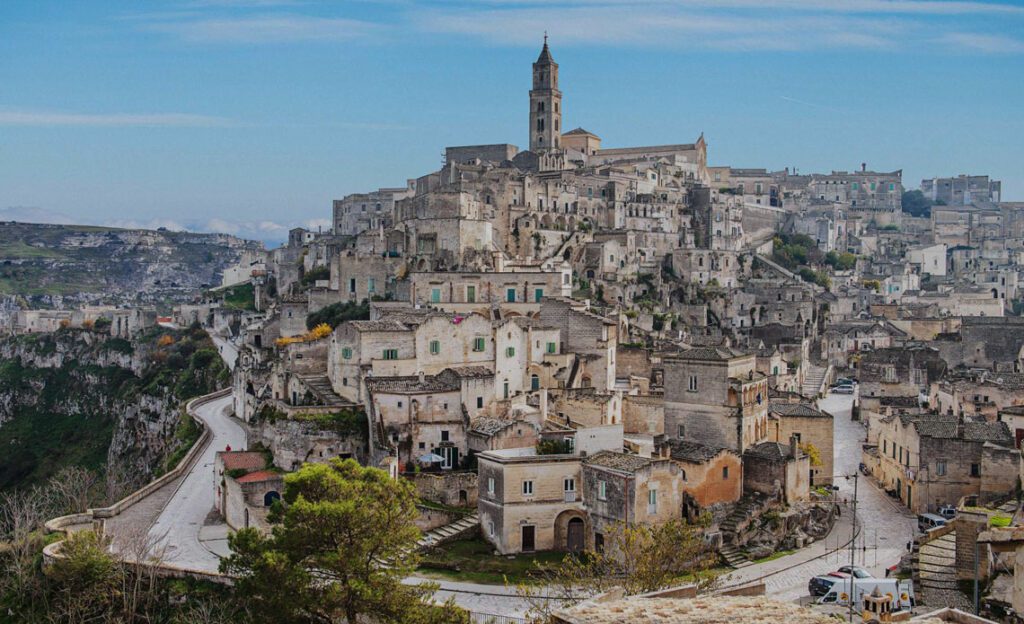
Visiting Matera means embarking on a journey through centuries of different civilizations, styles and cultures, from the Paleolithic to the present day, through the Middle Ages, the Renaissance and the Baroque. This experience will leave an indelible mark on your memory, as it was for me.
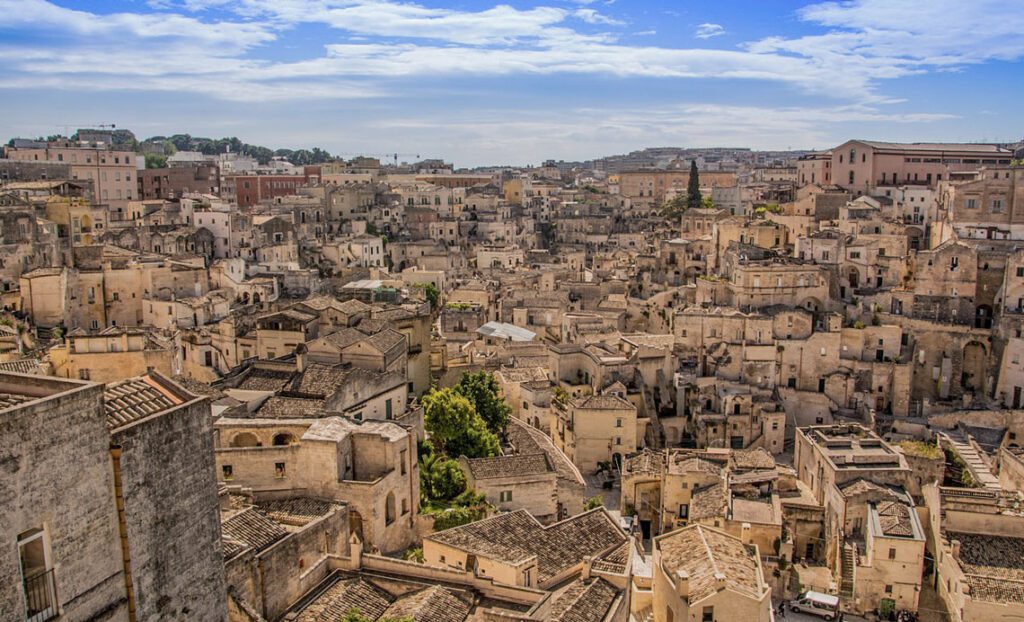
Why Matera is an unique place
Among the many reasons that bring you to Matera, the Sassi are probably the main one. Literally “Rocks”, Sassi of Matera is used to name two districts carved into the rock of the ravine (deep crevasse formed over the millennia by waterways) on which there are many buildings dug in tuff.
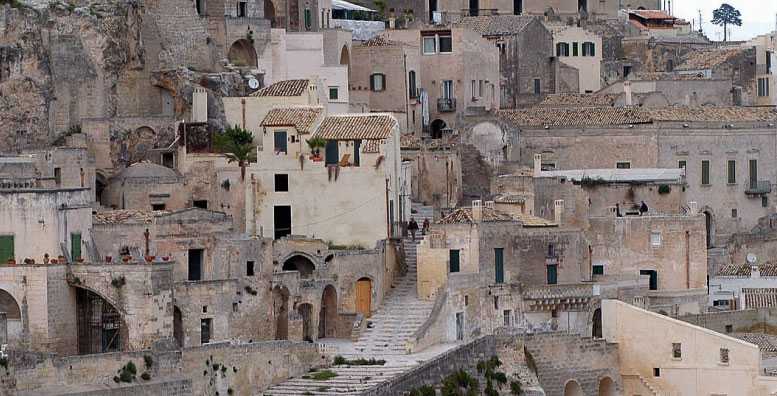
To the north is Sasso Barisano, which takes its name from the city of Bari being oriented towards the north-west, while to the south there is Sasso Caveoso, which takes its name from the city of Montescaglioso, known in the Middle Ages as Mons Caveous. Of the two districts the second is definitely the oldest.
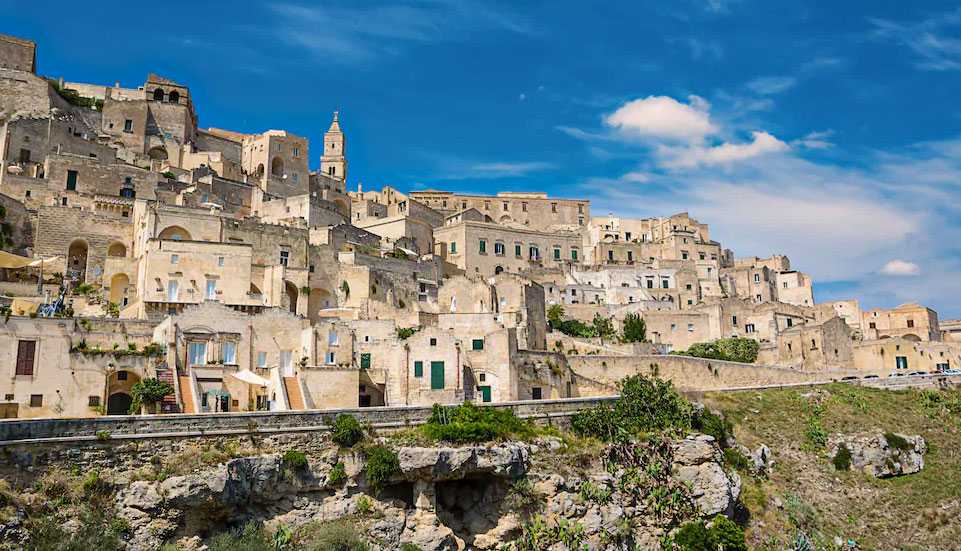
Both Sassi are therefore two valleys with the same geomorphological characteristics, two land depressions located at the foot of a hill on top of which stands the Cathedral Civita.
Civita is the point of origin, the first settlements were in fact in the area where the Cathedral now stands. Even if the cave houses seem arranged in an anarchist way everything leads back to the Civita as it used to be the center of the social and urban life of the Sassi.
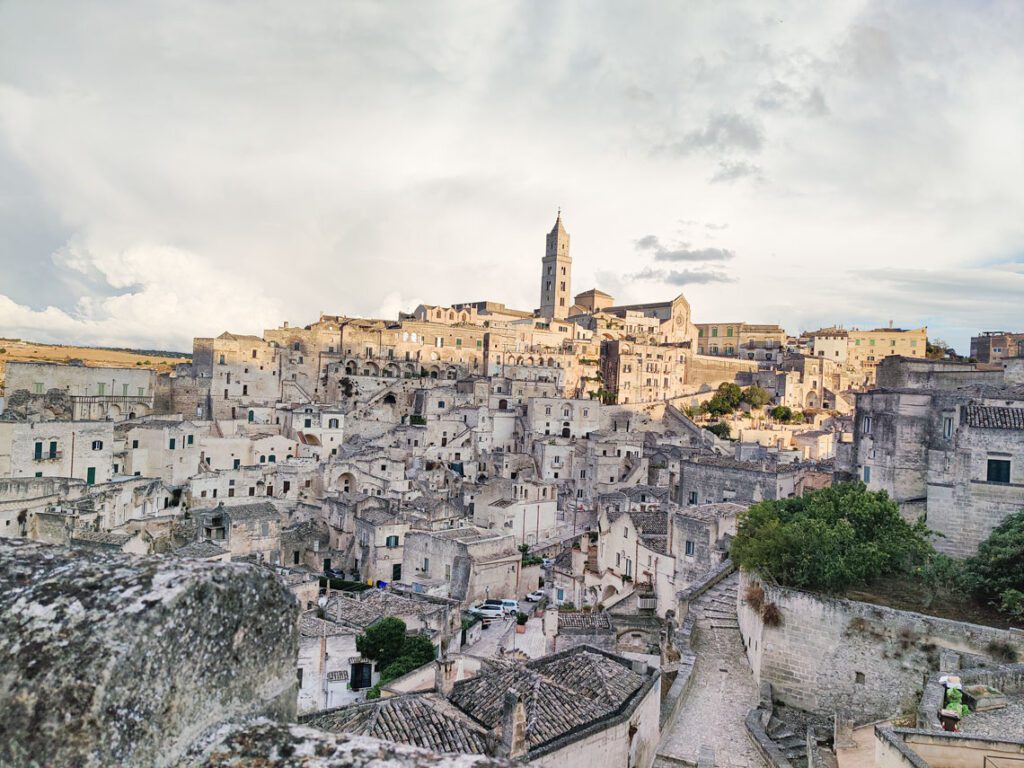
Looking at a panoramic image of Matera in its entirety the architectural difference of the two Sassi immediately catches the eye. In Sasso Barisano we can identify a positive architecture as caves are hidden by structures built outside with the same material of the cave. In Sasso Caveoso the architecture is instead negative, the caves and their frontal access can be clearly identified.
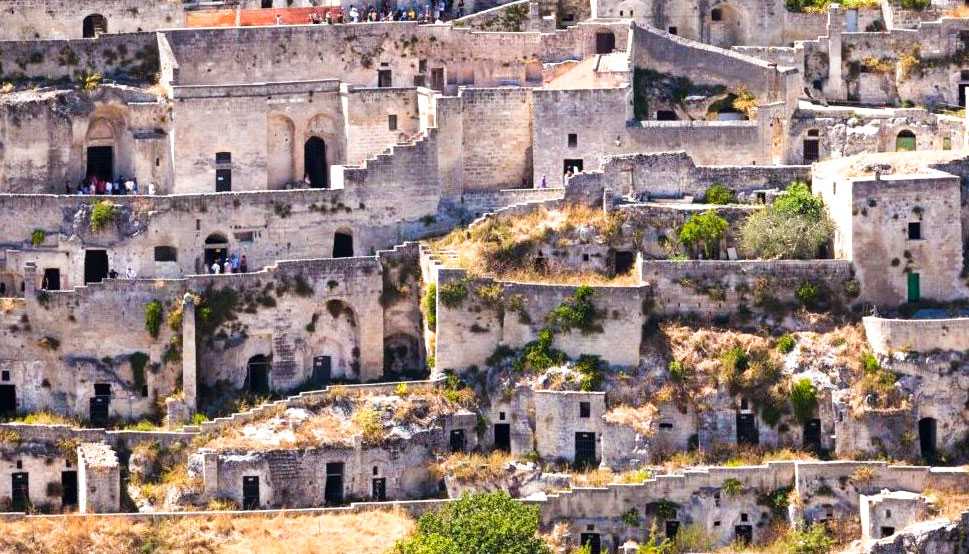
The urban development of Sassi is so intricate that between alleys and terraces you will find yourself walking on the roofs of houses without even realizing it. Suddenly you’ll be passing by a chimney that belongs to the house downstairs. They’ve built up to 11 overlapping levels of houses and maybe you will be walking on the top of them.
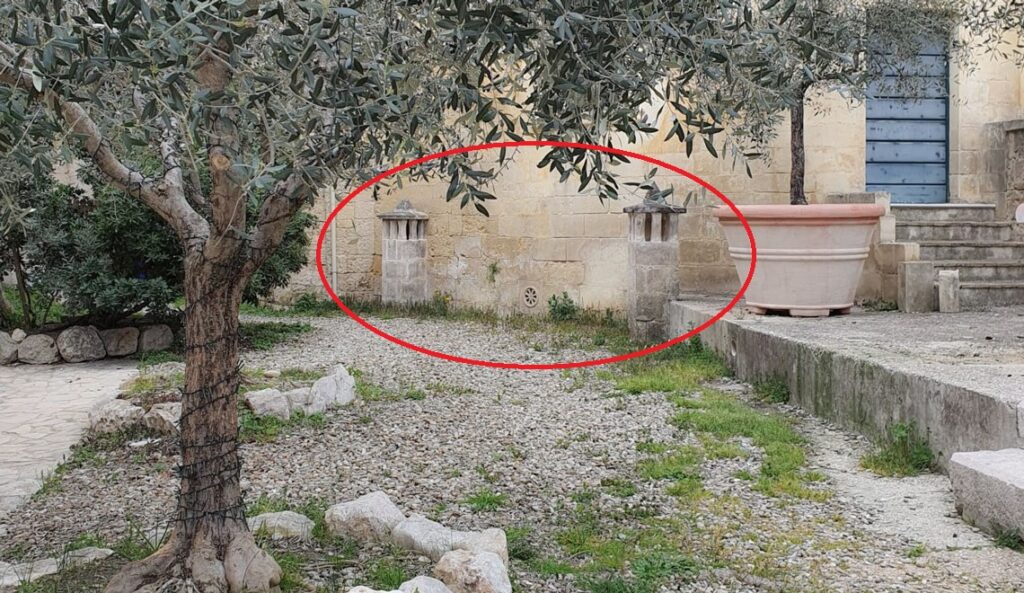
The cave houses – Le Case Grotta
These houses give a shape to the districts and consist mainly of a single room dug inside a rock bank with only one large opening at the entrance from which enter the sunlight. They used to be not only the home of the typical family of farmers from Matera but also the stable and the shelter of animals of all kinds. Under the floor there were in general a cistern or a complex system of collection and conveyance of water.
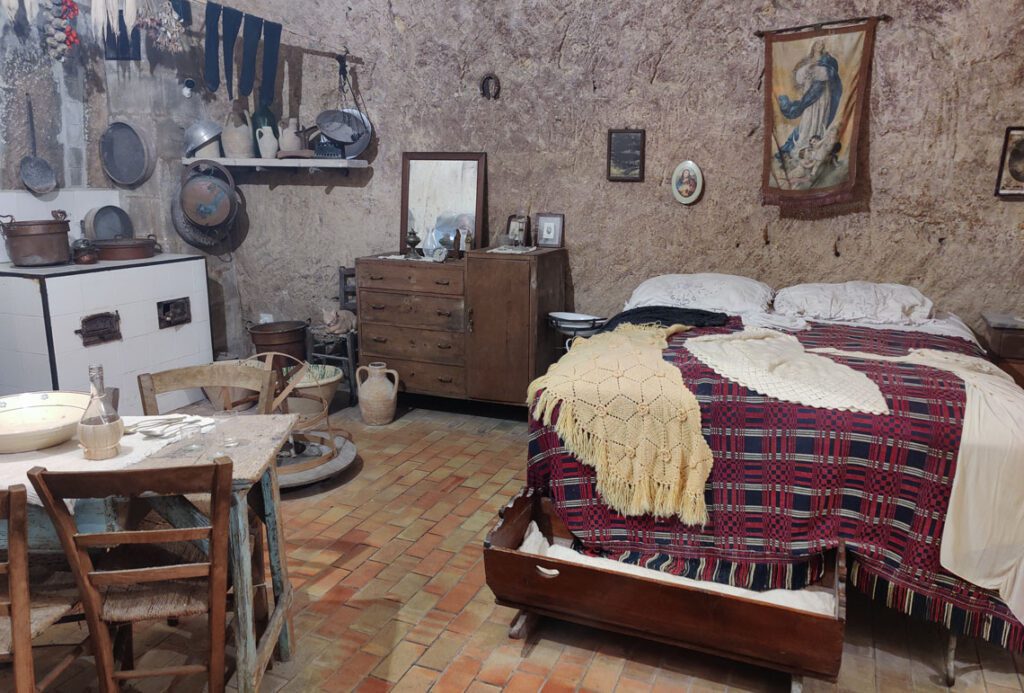
Of course the living conditions inside these rock-cut houses were far from healthy. There were no basic services such as running water and electricity and at that time the main streets through the two discricts were not actual streets but open sewers.
Nowadays for the tourists who visits Matera it is difficult to think that its history includes a terrible period that has even led to be defined as National Shame.
Almost all daily activities took place in the cave, from handicrafts to weaving, from food preservation to animal care. The hygienic conditions inside were so precarious that after World War II, in the 1950s, Alcide de Gasperi, the Prime Minister of the Italian Government, proposed a law that provided for the eviction of houses by the inhabitants of the ancient Sassi and the consequent population of a new area of the city.
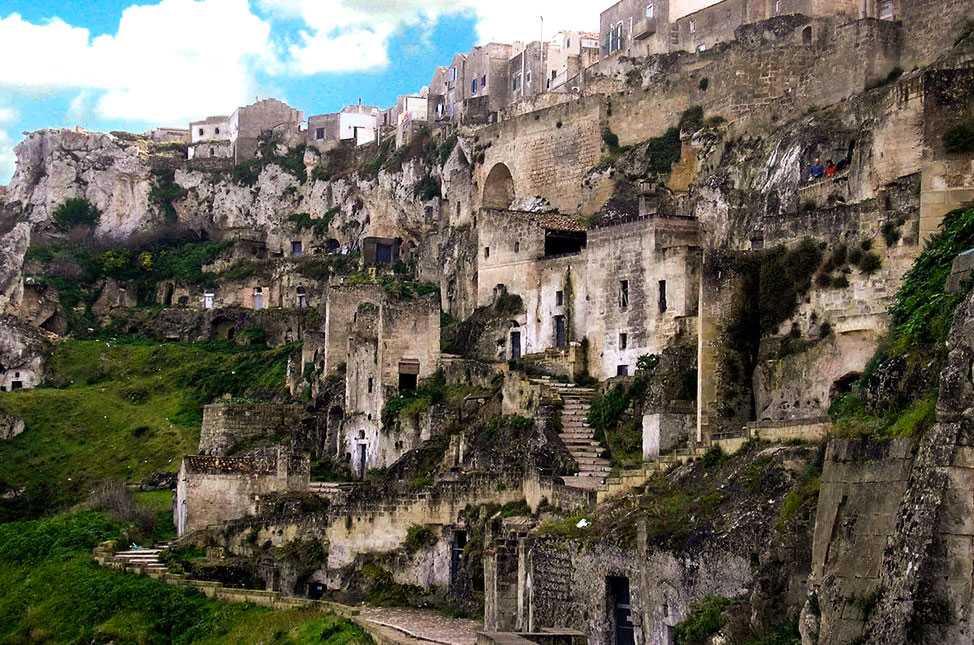
The famous cave districts (at the time with a negative connotation) were considered a National Shame and as a result remained totally uninhabited for almost 30 years.
The headlines of the newspapers reported praise and success for De Gasperi who had erased the National Shame from the Italian southern reality.
After the displacement, many questioned what should have been the fate of the Sassi, the “old city” almost deserted on the edge of a “new city”.
It will be only from the mid-80s that life will be back in the ancient heart of Matera, thanks to a special law of 1986, that allowed citizens to return to the old Sassi, this time with sewers, running water, electric light, heating and all the comforts of the modern life.
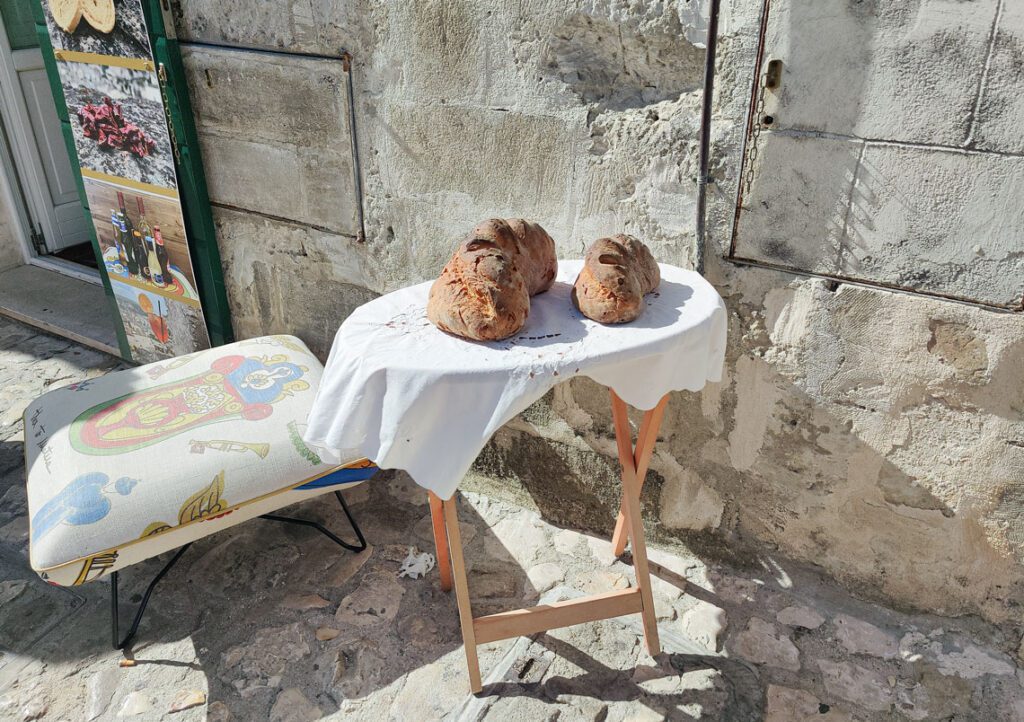
The great final push that accelerated the process of rehabilitation and redevelopment of the Sassi was given by the architect Pietro Laureano who presented the project Matera to UNESCO and Matera became a World Heritage Site.
In recent decades the city has undergone a remarkable urban development that have brought the Sassi to their ancient splendor. Thanks to the considerable increase of the tourist flow, more and more owners have repopulated the area by restoring houses and opening luxury hotels and businesses. With 7 votes out of 13, in 2014 Matera has been even officially designated European Capital of Culture for the year 2019.
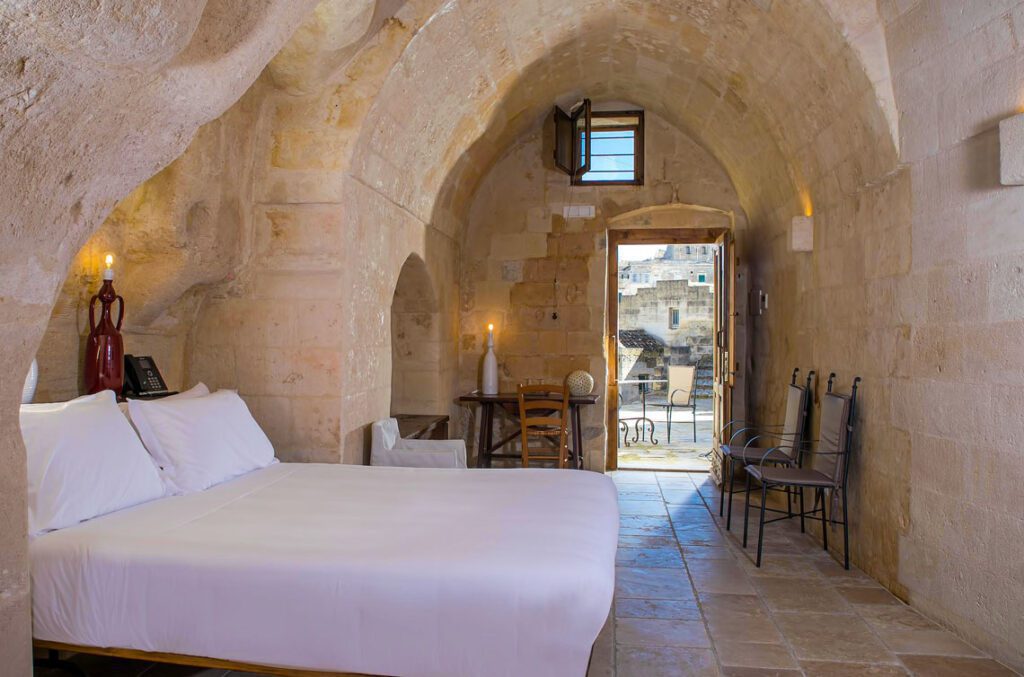
What to see and experience in the city of Sassi
To be honest, there is an obligatory route in the Sassi of Matera and it is to get lost! Starting anywhere, you have to enter the narrow streets, go up and down the long bleachers, without a goal but with the awareness of wanting to lose yourself! That’s the best way to discover the city.
However, if you don’t want to risk here is where you can start:

Piazza Vittorio Veneto and Palombaro Lungo
Let’s start to get acquainted with Matera from its main square, Piazza Vittorio Veneto, which is generally the starting point of many tourist routes. From here three tuff arches anticipate one of the most beautiful viewpoints of the city, the Belvedere Luigi Guerricchio, a panoramic balcony on Sasso Barisano.
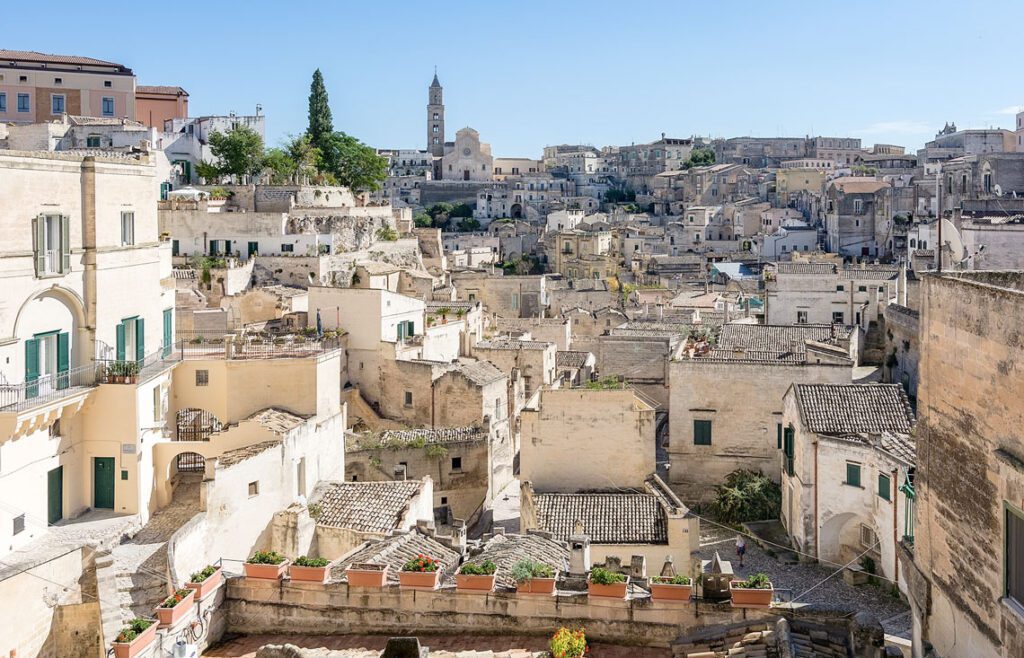
In addition, without you even realising it, in Piazza Vittorio Veneto you are already walking over one of the largest cavities, right under the white paved there is underground cistern – il Palombaro Lungo.
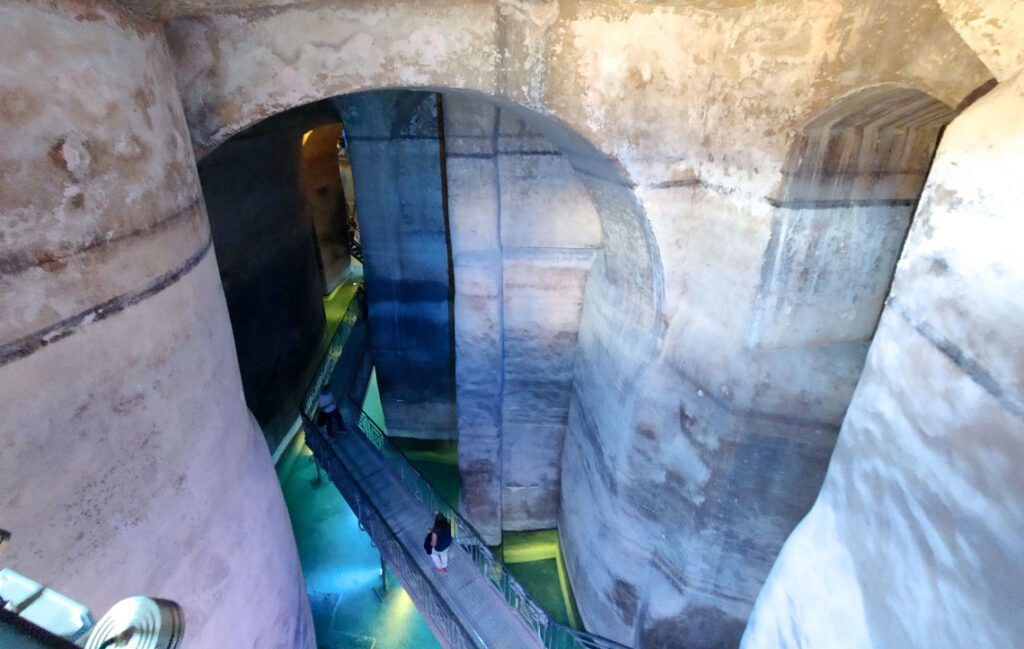
Il Palombaro Lungo is an underground cistern dug entirely by hand in which water was collected for the city. The size of this excavation is very impressive and thanks to different levels and stairs you can easily walk through it.
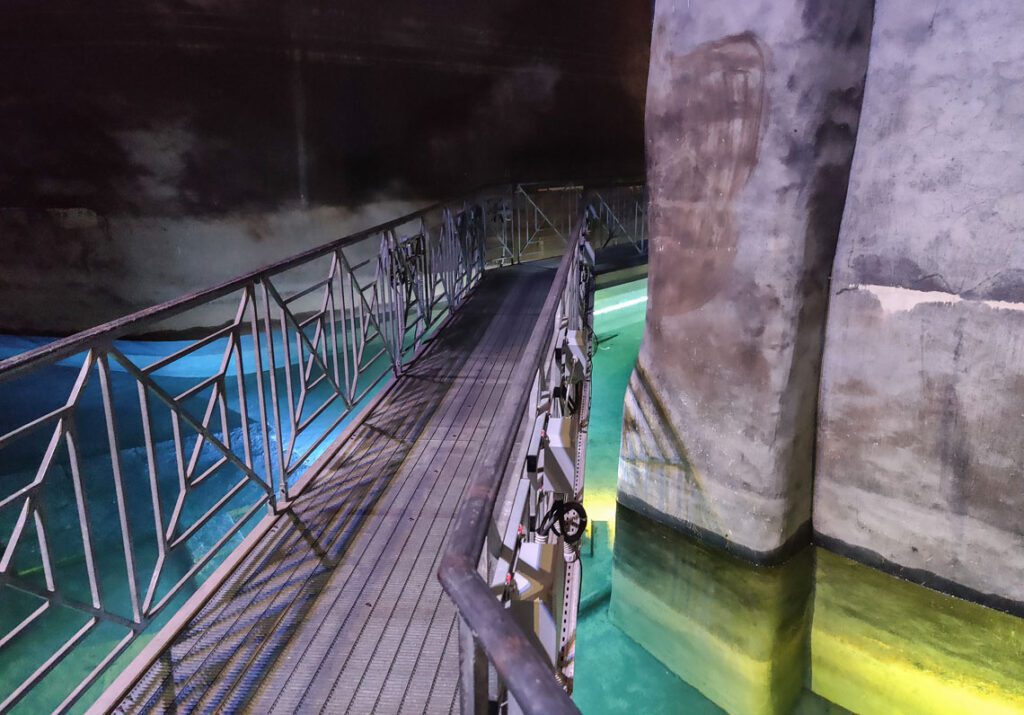
On the walls there are visible signs of wear left by buckets that carried water to the surface. The visit takes about 20 minutes and the ticket cost is € 3.00.
The official website
MateraSum Ipogeo
A few meters from Piazza Vittorio Veneto you will find the MateraSum. This Hypogeum is defined as a city in the city! Under the city’s condominiums there is an intricate system of underground caves completely unexpected. Thanks to an introductory video and audio guide you will be able to explore many environments of this immense hypogeum.
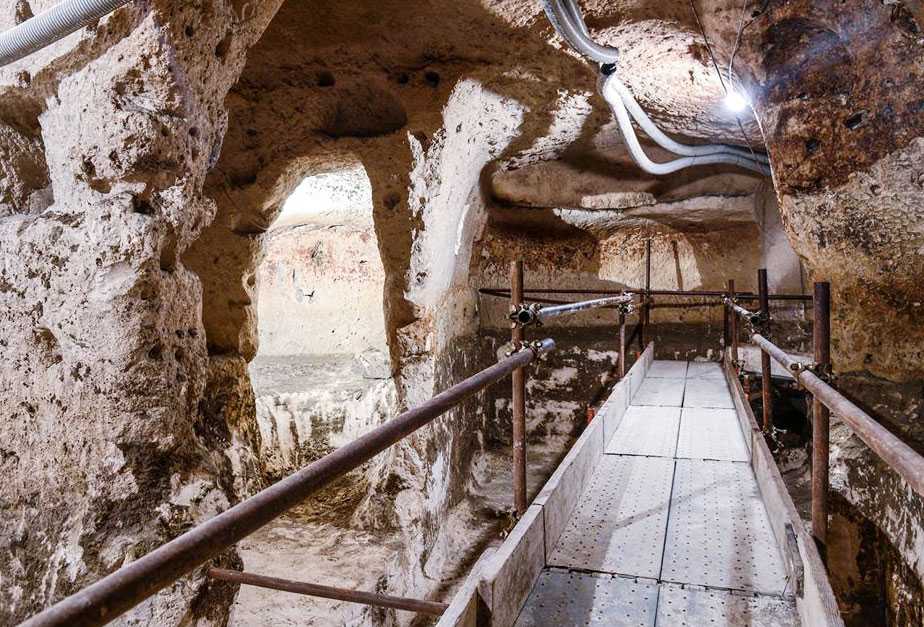
Note: Bring a sweater, since the thermal shock, especially in summer can be really annoying. It’s better to book your ticket in advance.
The offiical website
Panoramic street Via d’Addozio and the Church of San Pietro Barisano
Continue your road taking Via d’Addozio, leaving the panorama of the city behind and walking towards the Park of Murgia Materana. You will reach the largest Rock Church of Matera – the Church of San Pietro Barisano.
The church is a perfect example of the typical architectural structure of the Sassi: it has a facade built in tuff, but the interior is almost completely excavated. The Church dates back to the year 1000 and was known as San Pietro in Veteribus, the present facade dates from 1755, the year in which the church was restructured and partly altered.
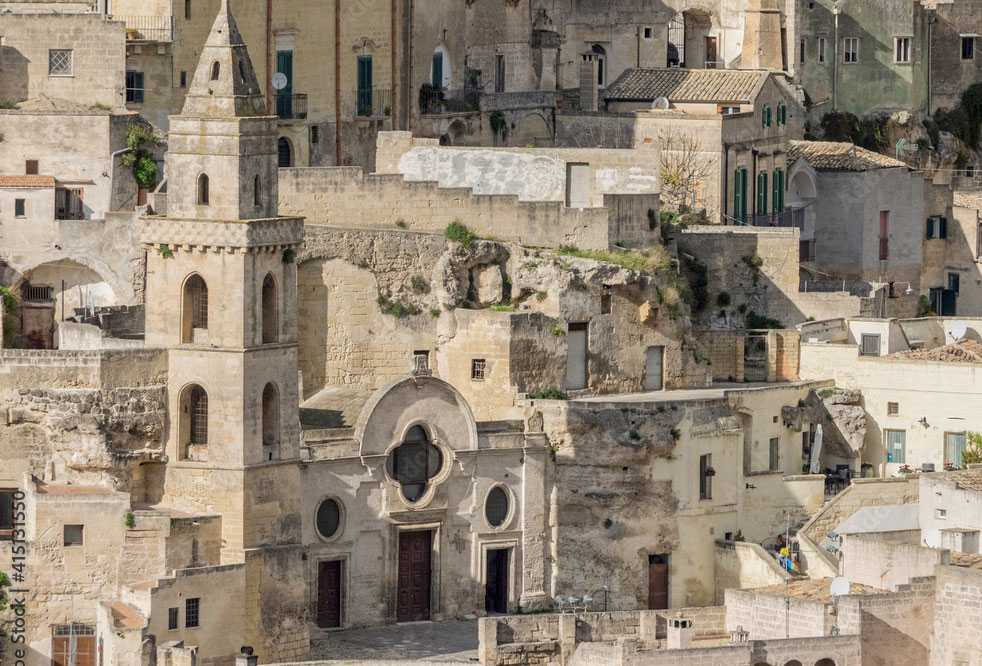
After the visit walk along Via Madonna delle Virtù, skirting the city and admiring the natural landscape and settlements dating back to the Paleolithic and Neolithic on the left.
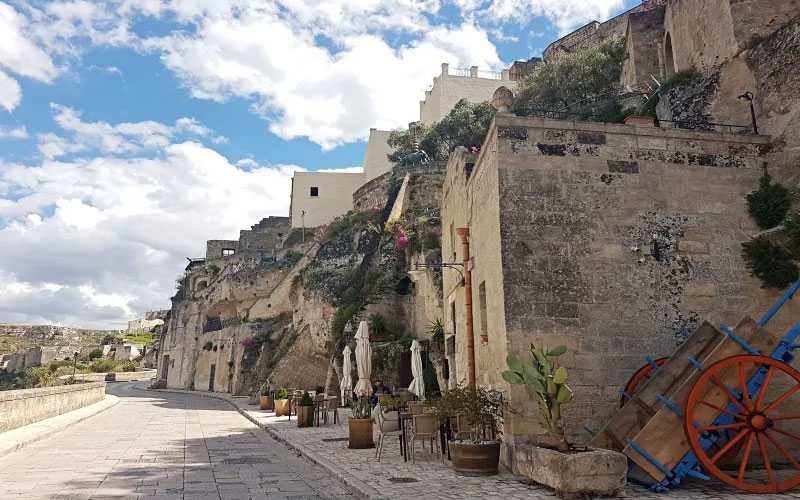
The Sassi in miniature
Before the road that leads to via Madonne delle Virtù on the right you can reach via Fiorentini, where you can visit the Sassi in Miniatura, built by a local craftsman. The sculpture of Maestro Rizzi reproduces accurately Sassi of Matera in a space of 12 square meters.
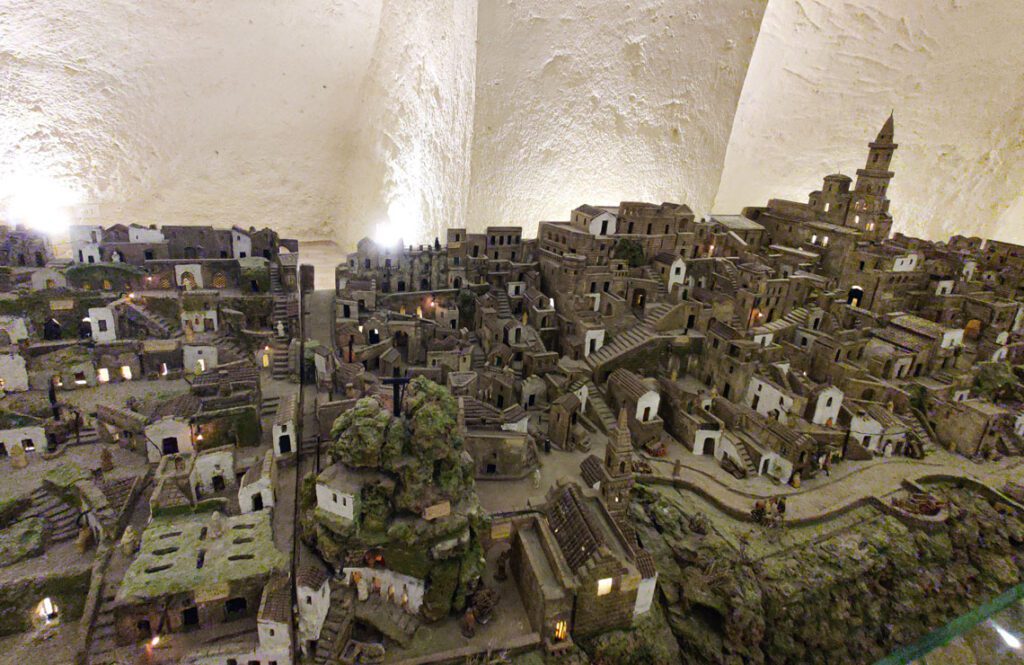
Here you can also buy excellent local crafts. Artistic craftsmanship in Matera boasts ancient traditions like works in tuff, a friable local stone.
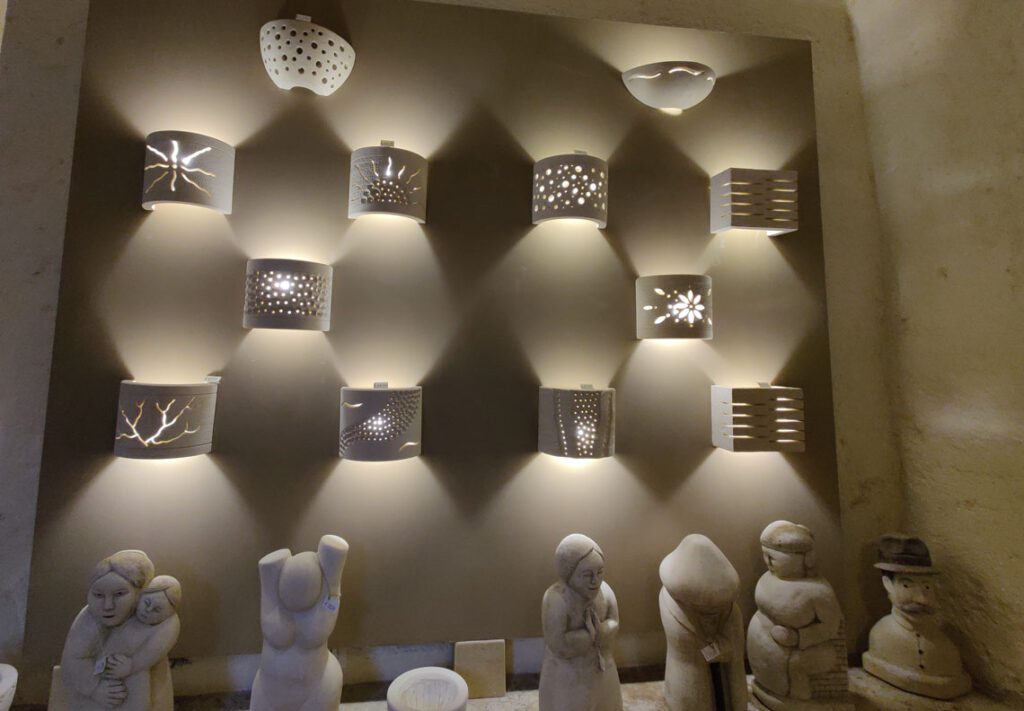
Symbol of light and prosperity in the Sassi is the Cuccù, a whistle in terracota.
I could not resist buying a traditional mold to mark the bread, you can also personalize it with your initials.
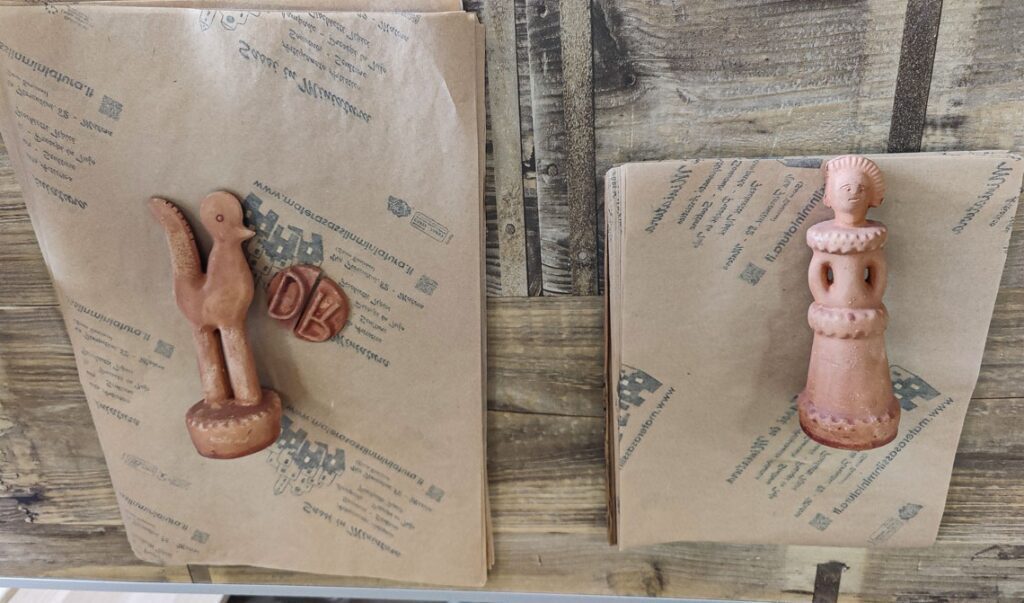
The Duomo Cathedral of Matera
One of the places that should definitely not be missed on your first visit is the Cathedral of Matera, which is dedicated to the SS. Madonna della Bruna and Sant’Eustachio and is located in the highest part of Matera, in the district Civita.
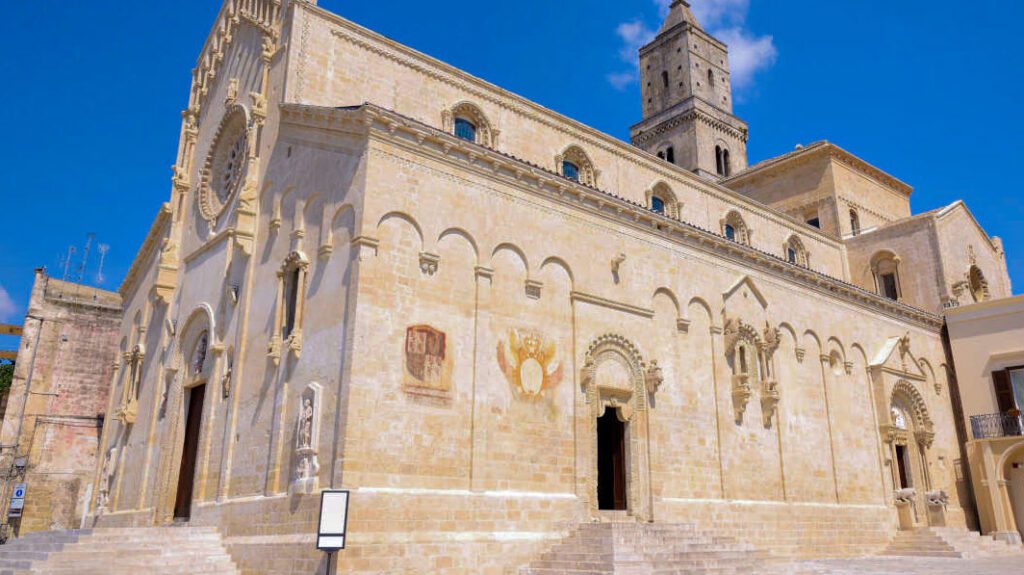
The Cathedral faces directly on Sasso Barisano but continuing through the alleys to its right you can look out on Sasso Caveoso. Both paths are very suggestive.
💡 Note: Ticket cost is 3,50 euro. It is a cumulative ticket that includes both the entrance to the Cathedral and the Diocesan Museum.
Street Via Muro
Just a 3 min walk from the Duomo Cathedral and you will find the entrance to Via Muro. The descend from the famous Via Muro is something exceptional, especially in the evening. It is considered to be one of the most beautiful streets in Matera. Via Muro is known for the staircase of the Way of the Cross, immortalized by Mel Gibson in the film The Passion of Christ.
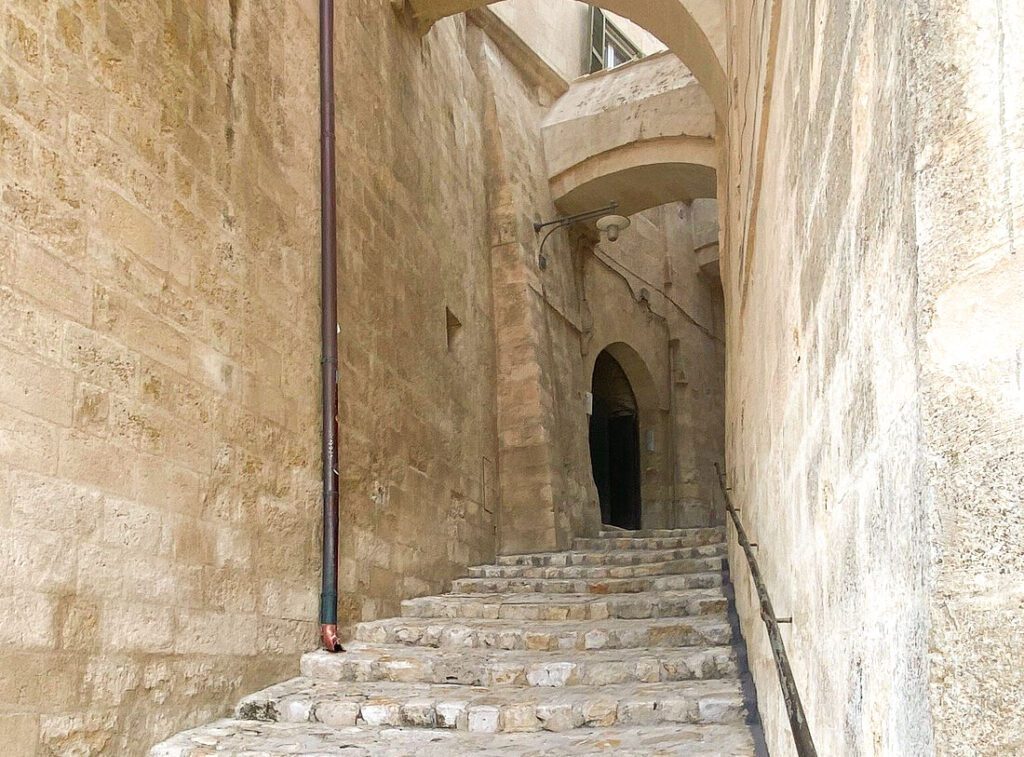
The Rock Church of Santa Maria di Idris
Now it’s time to reach Sasso Caveoso. The Church of Santa Maria De Idris is located in the upper part of the rocky spur of Montirone (or Monterrone), near San Pietro Caveoso. Make an effort to reach the Church of Santa Maria di Idris and you will be rewarded: the building is spread over a rocky spur which gives a spectacular view of Matera.
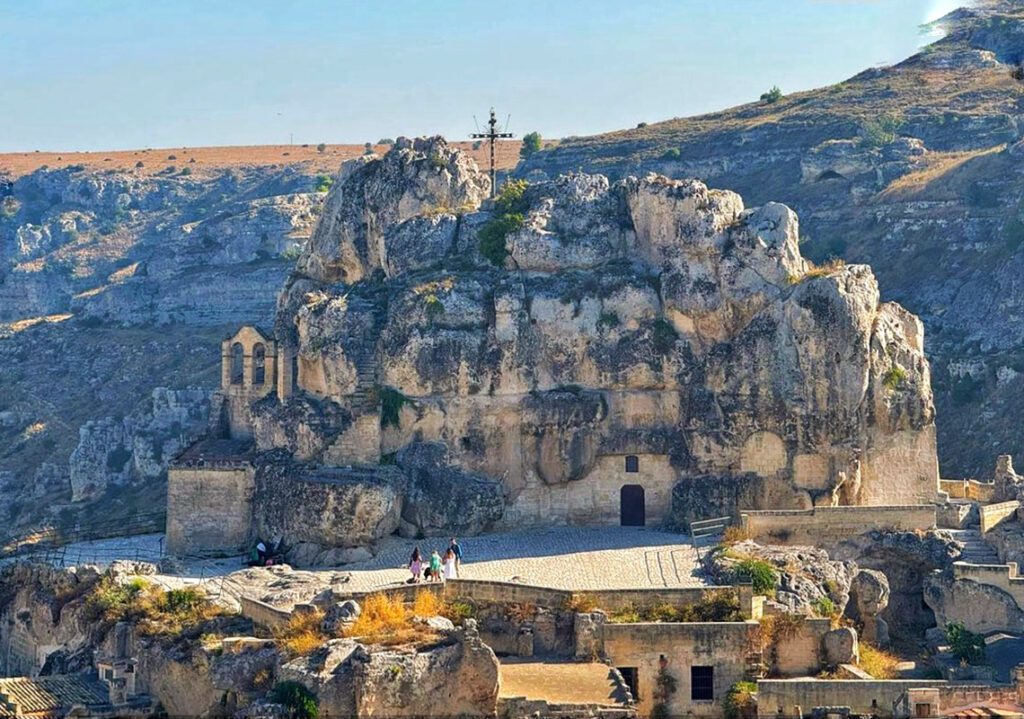
This church dates back to the three-fifteenth century and is part of a rock complex that also includes the oldest crypt, dedicated to San Giovanni in Monterrone. The latter is important for the frescoes that preserves, ranging from the twelfth to the seventeenth century.
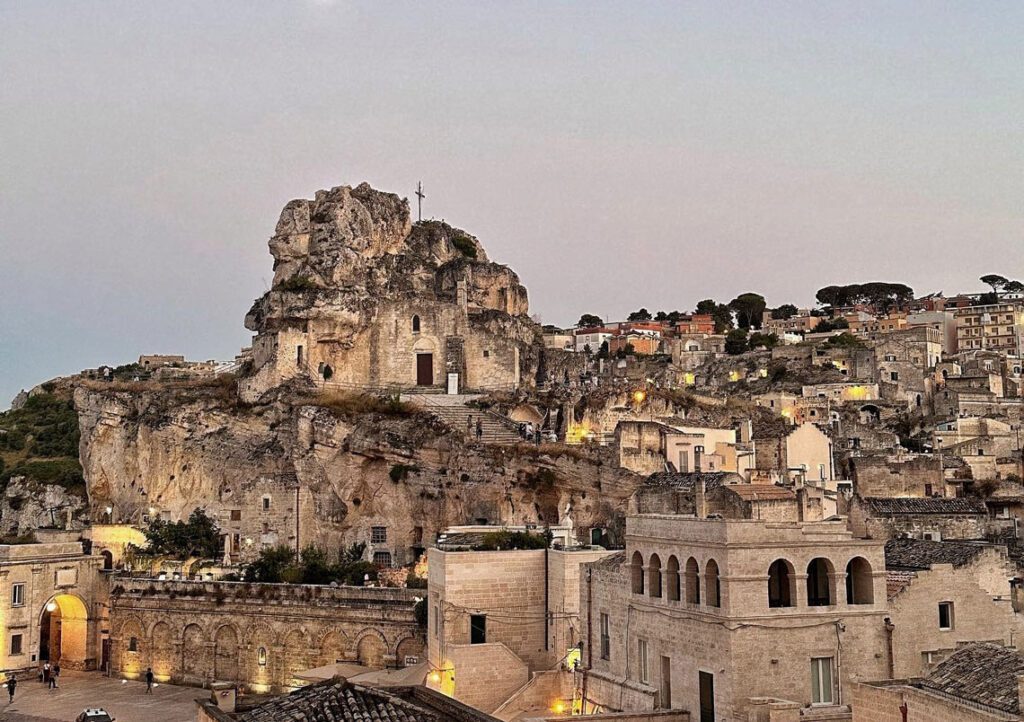
If you are as lucky as me, there by chance at sunset, you can witness the moment of transformation: the city lights up for the night turning into a living crib. After a full day spent learning about the aspects of Matera, this was the moment I fell in love with the city. Make sure you also have the opportunity to appreciate its intimate beauty.
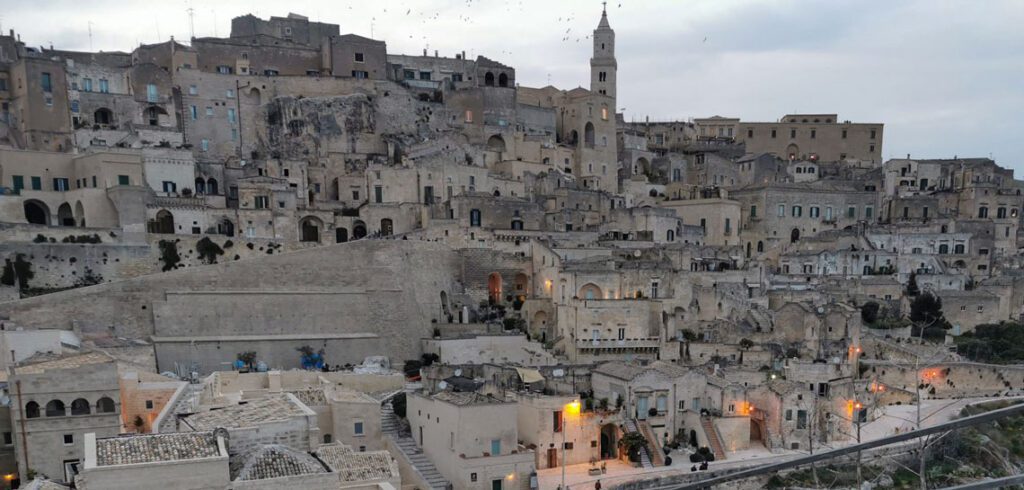
The Casa Grotta di Vico Solitario and Casa Grotta del Casalnuovo
To better understand how people used to live in Sasso Caveoso I suggest to visit Casa Grotta di Vico Solitario, a recovered cavity which now has became a sort of small museum, set up with original tools and furnishings of the time. Nearby there is also Casa Grotta del Casalnuovo, another example of how man had adapted to the caves.
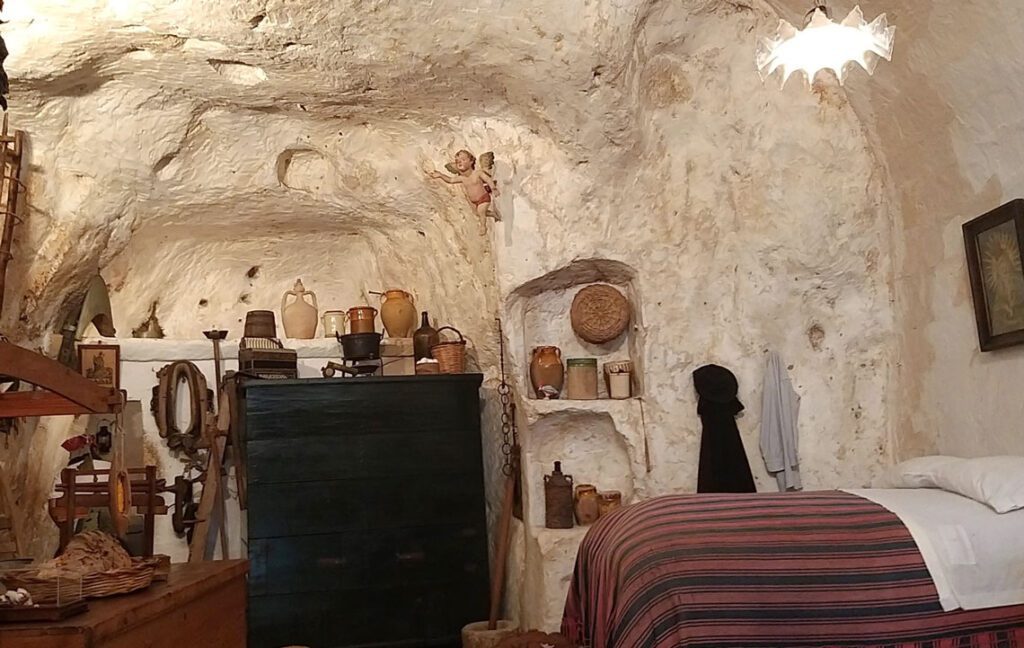
Belvedere of Piazzetta Pascoli
Belvedere of Piazzetta Pascoli is certainly one of the most crowded. If you have ever seen Matera on TV, you will recognize this corner instantly, since it is definitely the most loved by photographers.
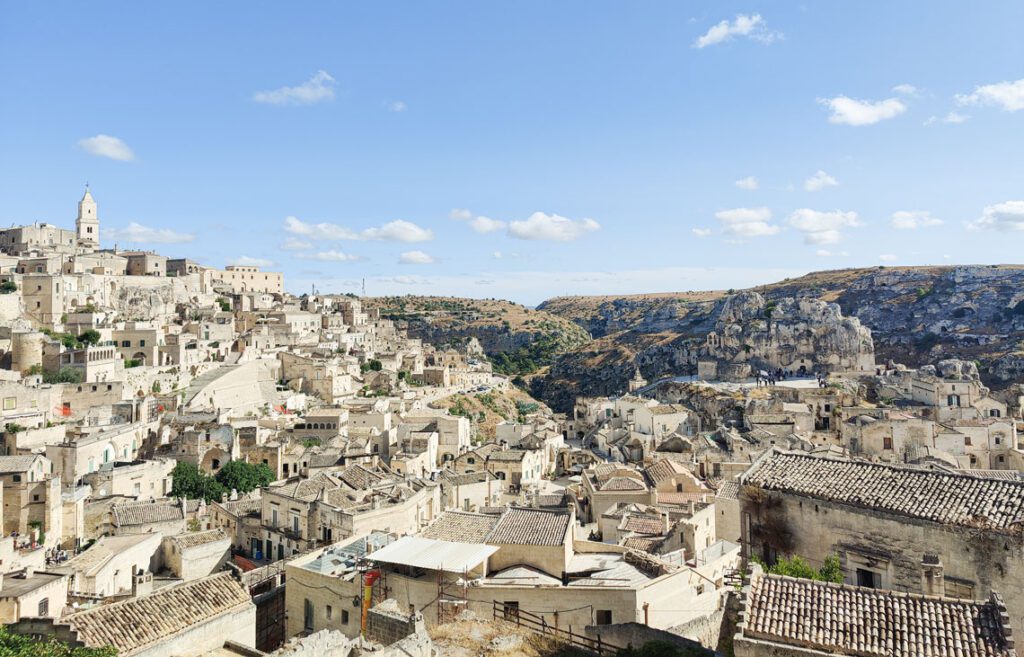
From this privileged position you can admire the districts Civita and Sasso Caveoso in all their splendor, above all in the evening then they turn into a romantic dream.
It is no coincidence that the square takes its name from a famous poet Giovanni Pascoli who here began his career.
Regional Park of Murgia Materana
Let’s take the chance to admire Matera from another perspective.
From the viewpoint of Murgia Timone, during sunset in the golden hour, you can clearly experience why Matera is also considered the crib of Basilicata. A sensational spectacle that remains etched in memory.
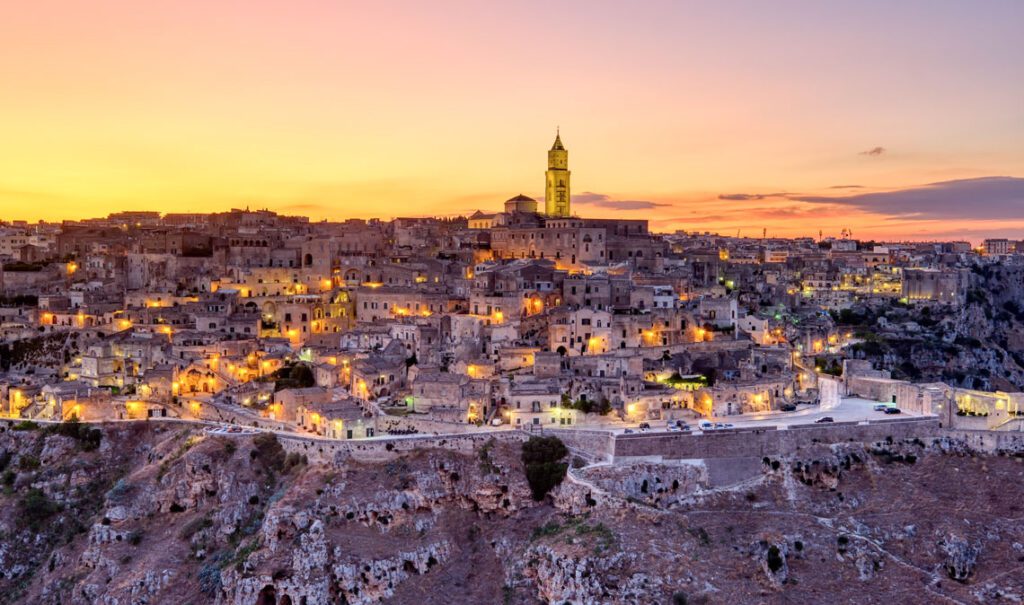
Be careful to be back before it’s getting dark, as in natural park you can spot wild boars.
We went there by car but the last kilometer was not accessible so you’ll have to walk it. Comfortable shoes and a bottle of water with you. To reach the precise parking spot use the GPS and set Jazzo Gattini.
Murgia park can be reached also by shuttle or by trekking or even crossing a Tibetan bridge!
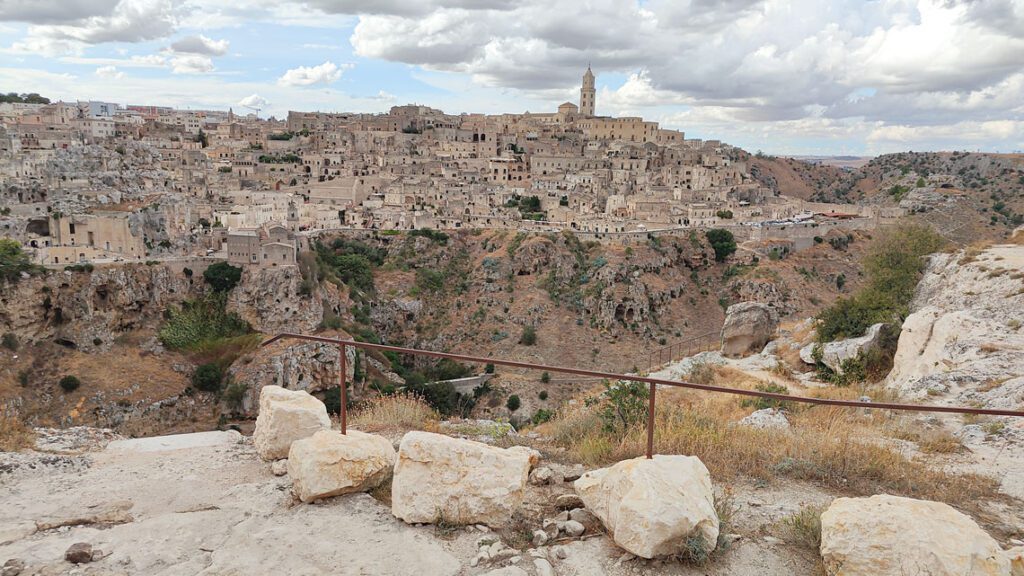
The Tibetan bridge
The bridge is inserted in the sinuous rocky coves and cross the canyon. This pedestrian walkway is one of the main attractions for hikers, even less experienced. One meter wide, suspended 9 meters from the stream Gravina, allows tourists to cross the stream and reach the Belvedere Murgia Timone in the Park of Murgia Materana. It is very suggestive and offers the opportunity to look at the landscape from a very different perspective.
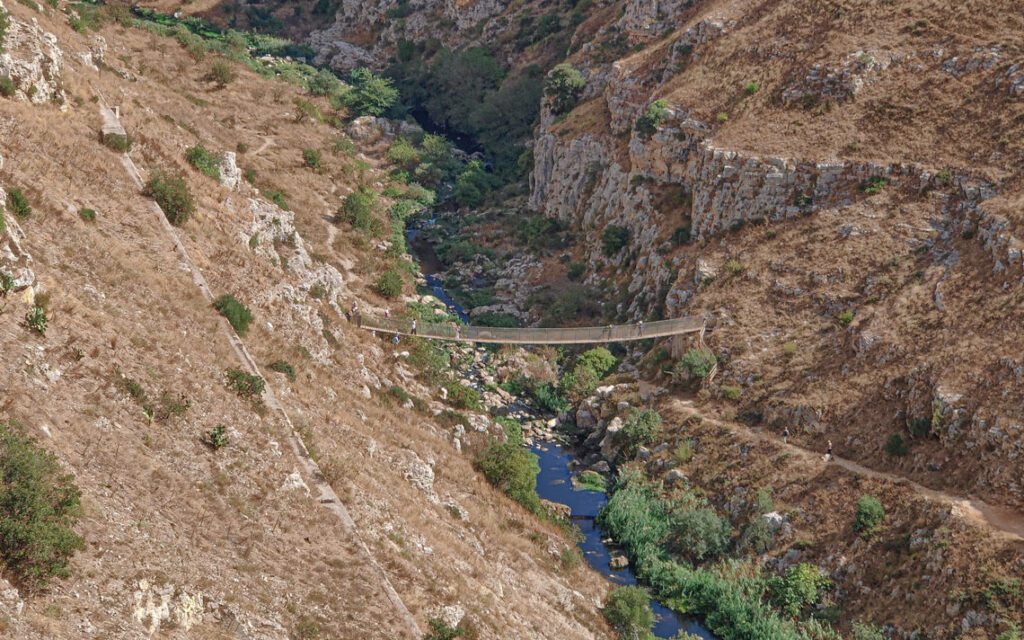
The trekking path is not recommended to children and elderly because of the angle of some slopes and the lack of protection in some points.
Museum of Contemporary Sculpture Il MUSMA
For those who love sculpture, is also recommended the MUSMA, the Museum of contemporary sculpture of Matera, which is spread over two levels: the upper one is housed in the Palazzo Pomarici, while the lower floor is located underground in the same building inside caves.
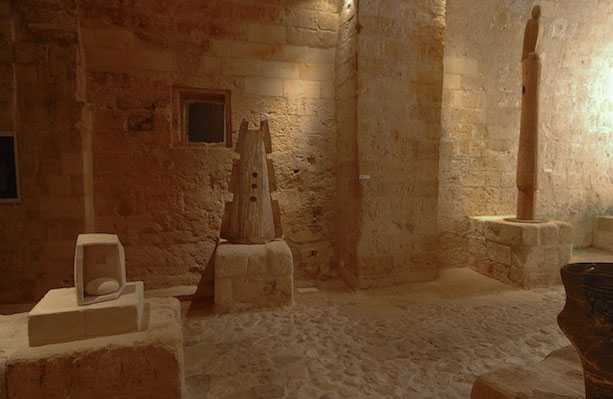
This encounter between modern sculpture and historical environments of the stones of Matera makes the place very impressive.
Ticket price: 7 €
The official website
Movie sets
With its rare and unique beauty Matera has conquered photographers and filmmakers from all over the world. I’ll be honest, you’ll have to be at least a bit fond of cinema to recognize the glimpses of Matera that have appeared on the small and on the big screen.
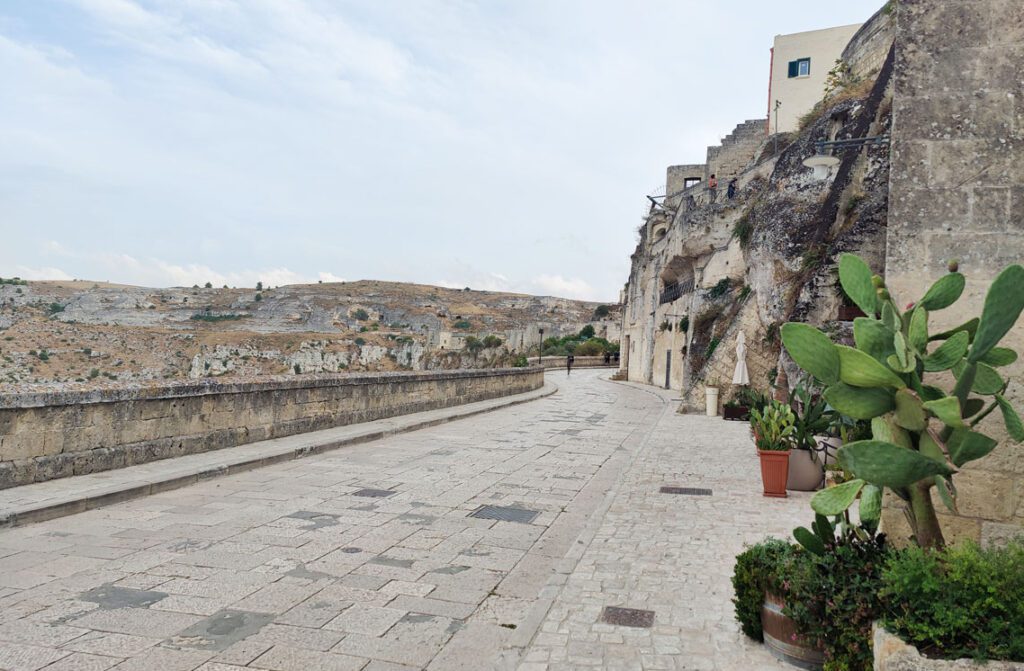
In any case, keep in mind that these streets are continually crossed by great masters of Italian cinema and Hollywood stars. Just to make an absolutely short list here are some films shot in Matera:
• “The devil” (1963) by Brunello Rondi
• “The Basilisks” (1963) by Lina Wertmüller
• “Christ stopped at Eboli” (1979) by Francesco Rosi
• “Del perduto amore” (1998) by Michele Placido
• “The Passion” (2002) by Mel Gibson
• “007 No time to die (2019)” by Cary Fukunaga
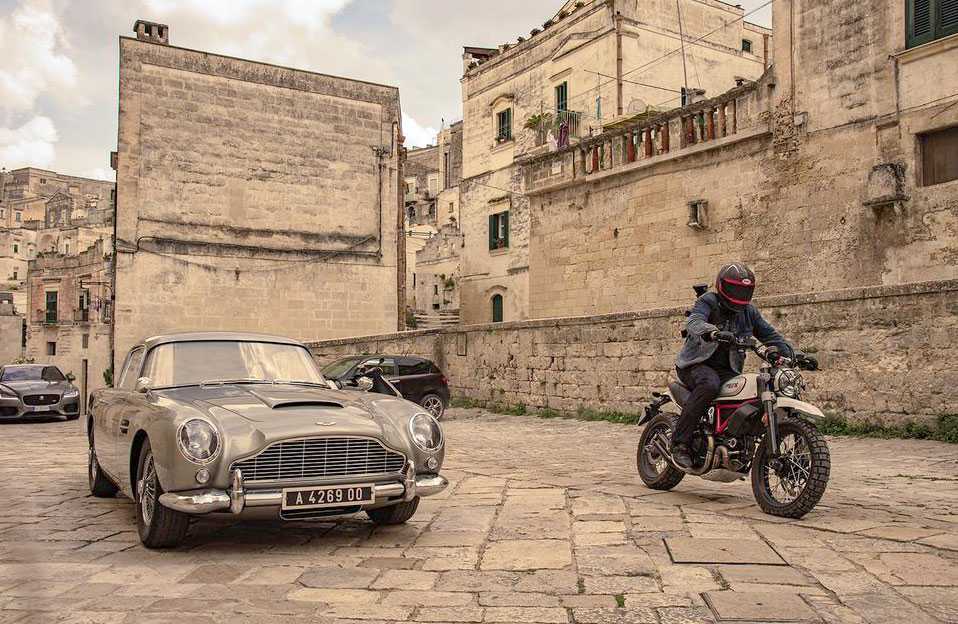
La Cripta del Peccato Originale – The Crypt of the Original Sin
A few kilometers from Matera there is another wonder that leaves stupefied everyone who visits it. The Crypt is located along the wall of the Gravina di Picciano, just outside Matera and basically it is a beautifully frescoed Cave Church, called the Sistine Chapel of rock wall painting.
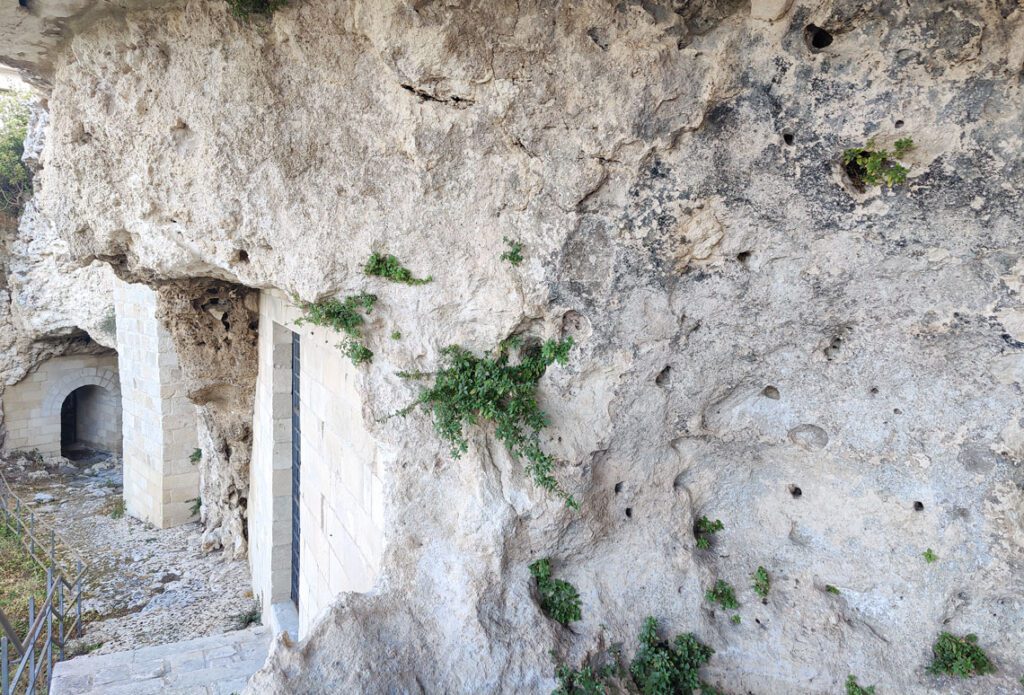
The extraordinary pictorial complex of Benedictine school – Beneventan (sec. VIII – IX) is undoubtedly one of the most important evidence of early medieval painting of the Mediterranean area.
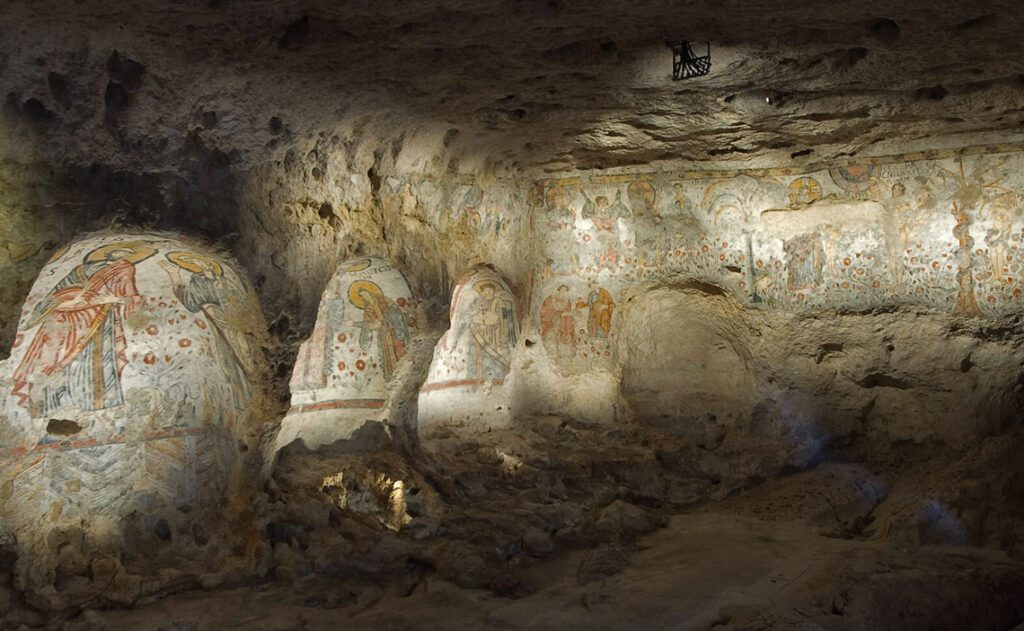
Used for a long time by shepherds as a shelter for animals, the natural cavity was known to the local population as the Cave of the Hundred Saints, for the presence of the many saints depicted on the walls.
On the back wall are illustrated some biblical scenes related to Genesis (God the Creator Father, the Light, the Darkness, the creation of Adam, the birth of Eve, temptation and Original Sin) while in the three apse basins are depicted the Apostles, the Archangels and the Virgin. The author of these extraordinary figurative works is unknown, simply remembered as the Painter of Flowers of Matera because of the many flowers with red petals in the lower part of the frescoes.
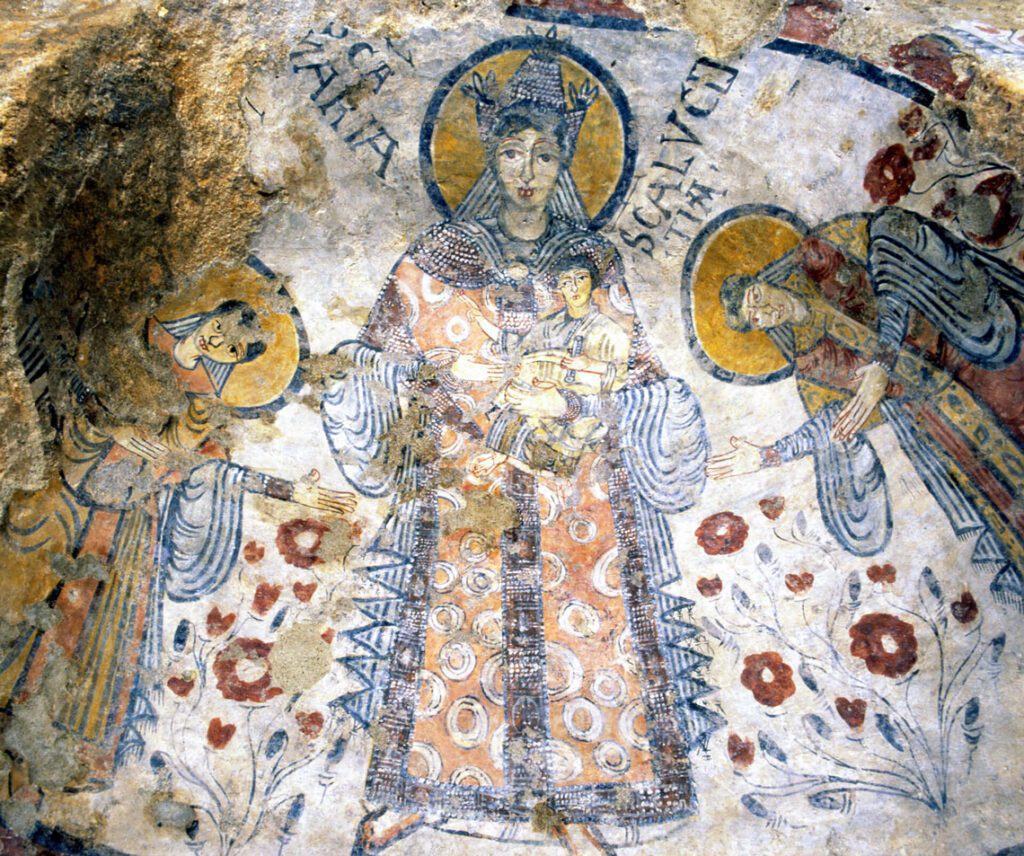
Note: the Crypt of Original Sin is visited only by reservation as access is allowed to a limited number of people.
Booking at +39 320 3345323.
Ticket price: 10 €
Directions: Strada Provinciale Fondo Valle del Bradano on the SS7 Appia.
The official website
Nearby the Crypt, you can stop for tasting or purchasing local products. The farm Agricola Dragone is a mandatory stop to live an experience of wine and culture of Lucania.
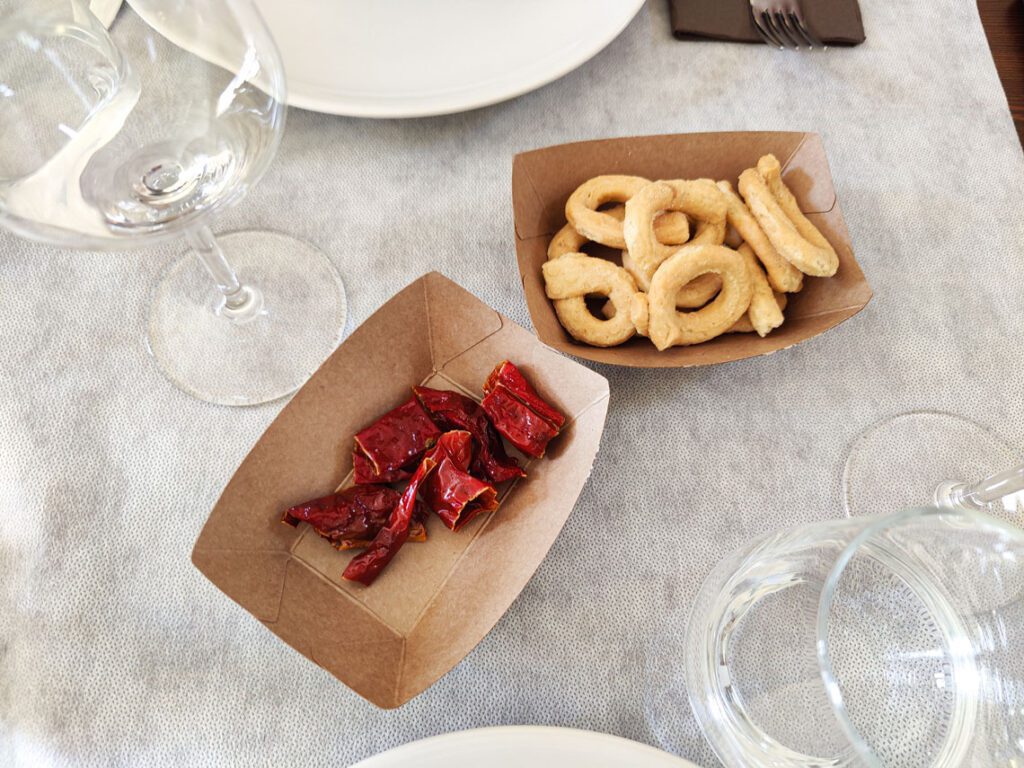
Note: for lunch or tasting experience the reservation is recommended.
What to taste in Matera
What about having dinner or an aperitif in a setting excavated in the rock? Here a selection of places that worth a stop during your trip.
Suggestive view with refined drinks at Zipa Cafè
My aperitif in Zipa Cafè was a unique and almost surreal experience. The place is located at the foot of the iconic rock church dedicated to Madonna of Idris and it is entirely built inside the rock.
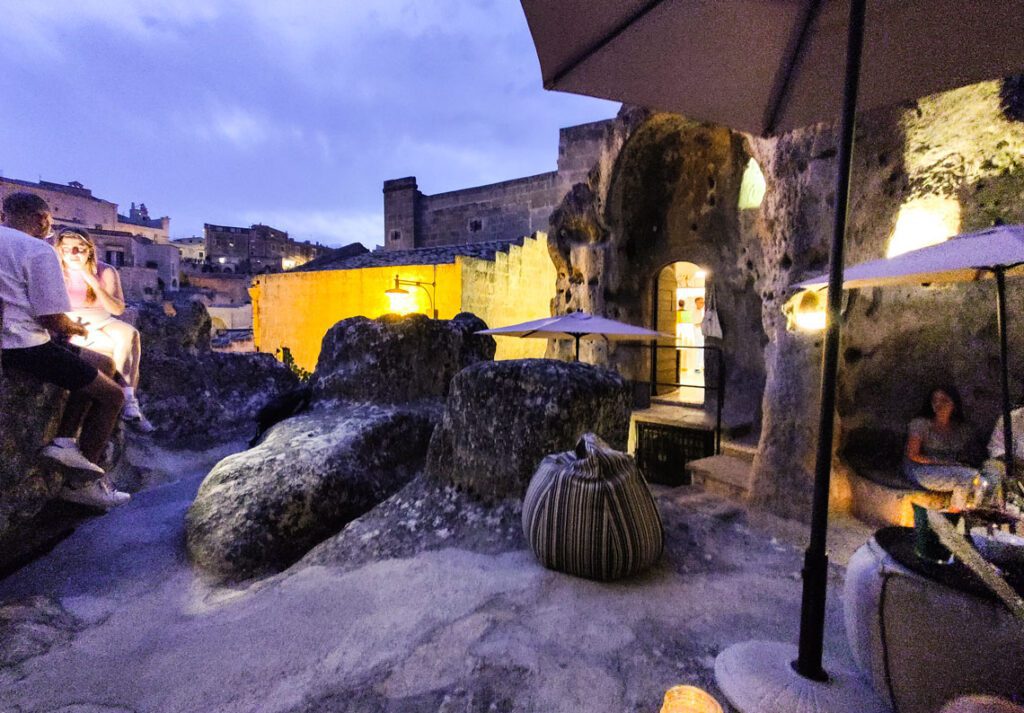
The seats are enriched by comfortable pillows and poufs and you can enjoy a view on Sasso Caveoso, sipping refined drinks and tasting local snacks. Every bite is an explosion of tastes of the territory of Lucania.
The staff is very friendly and prices are very affordable.
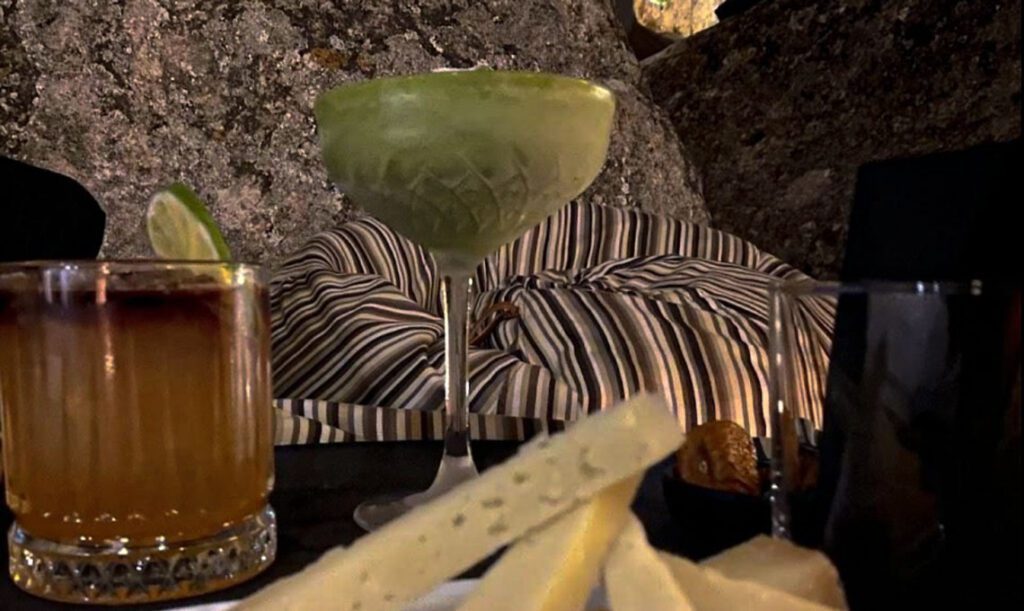
Address: 15 via Madonna dell’Idris, 75100, Matera
Aperitif at sunset on Quarry Lounge Terrace
Quarry Lounge Terrace is located two minutes away from Via Muro and offers a spectacular view on Sasso Caveoso.
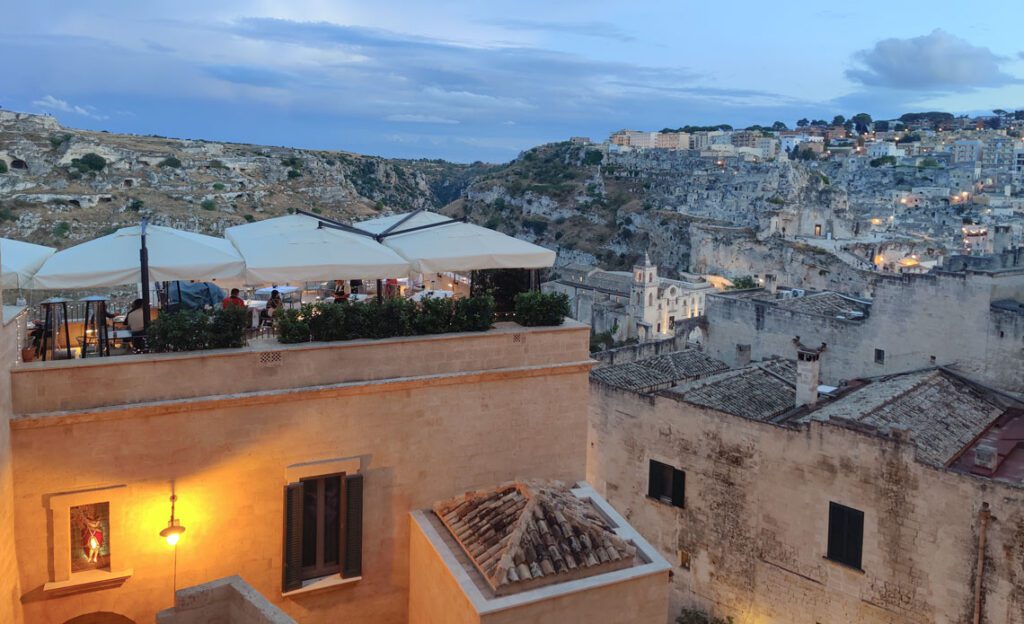
Here every detail is harmonious and elegant. Friendly staff offers to taste their local oil. Land or sea appetizers hide the secrets of the kitchen of Matera. All products are of superb quality, cocktails included.
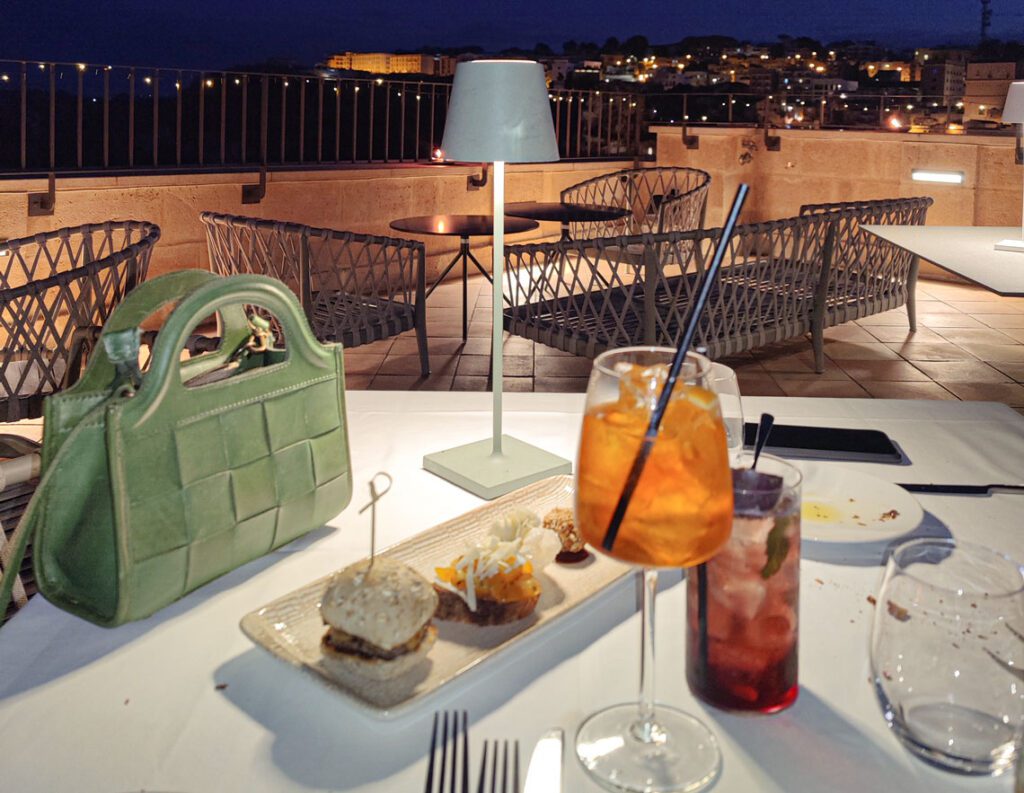
Price for cockatil + aperitif of sea or land menu: 20 euro.
Address: Via San Giacomo, 39 Quarry Resort, 75100, Matera Italy
Osteria Al Casale to dine in a cave
I followed local people advices and ended up to in a fabulous reality. You do not dine in this restaurant for the view but for the uniqueness of the dishes that are offered. The atmosphere is also very suggestive being the setting carved into the calcarenite (the rock of Matera) and light up with magic lights.
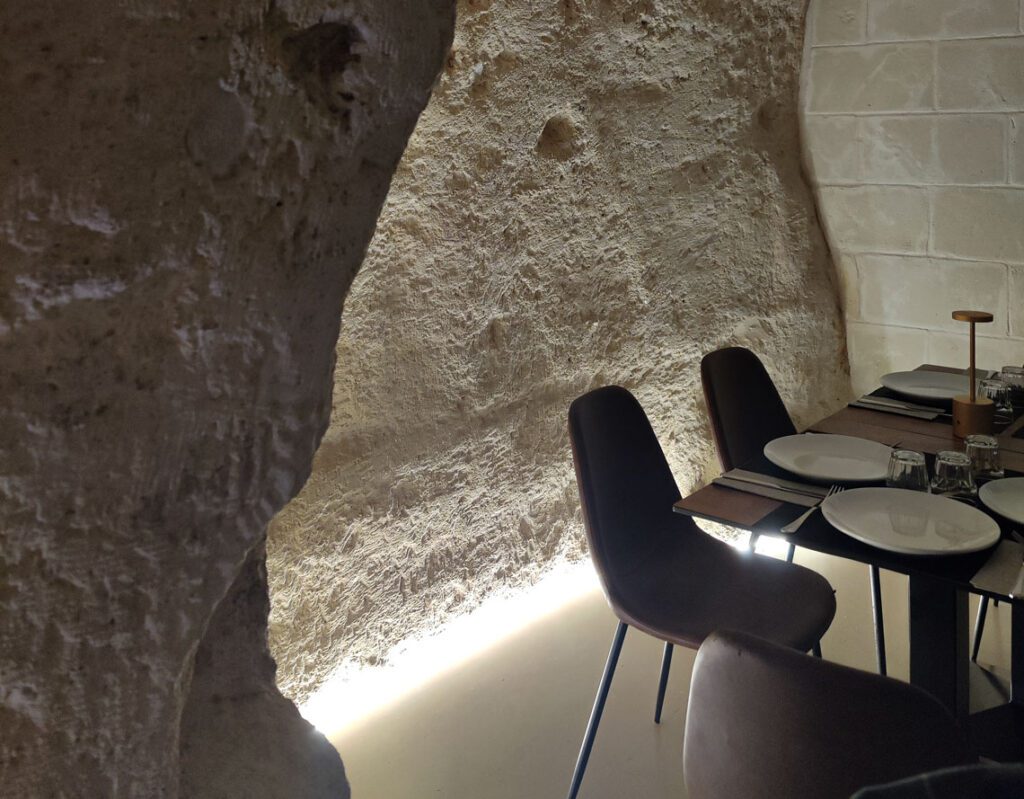
Bread balls as an appetizer, soft spicy and extremely tasty; delicious capunti mussels, cream of beans and breadcrumbs fried, scialatielli mushrooms with caciocavallo and Crusco pepper; everything here is matching right.
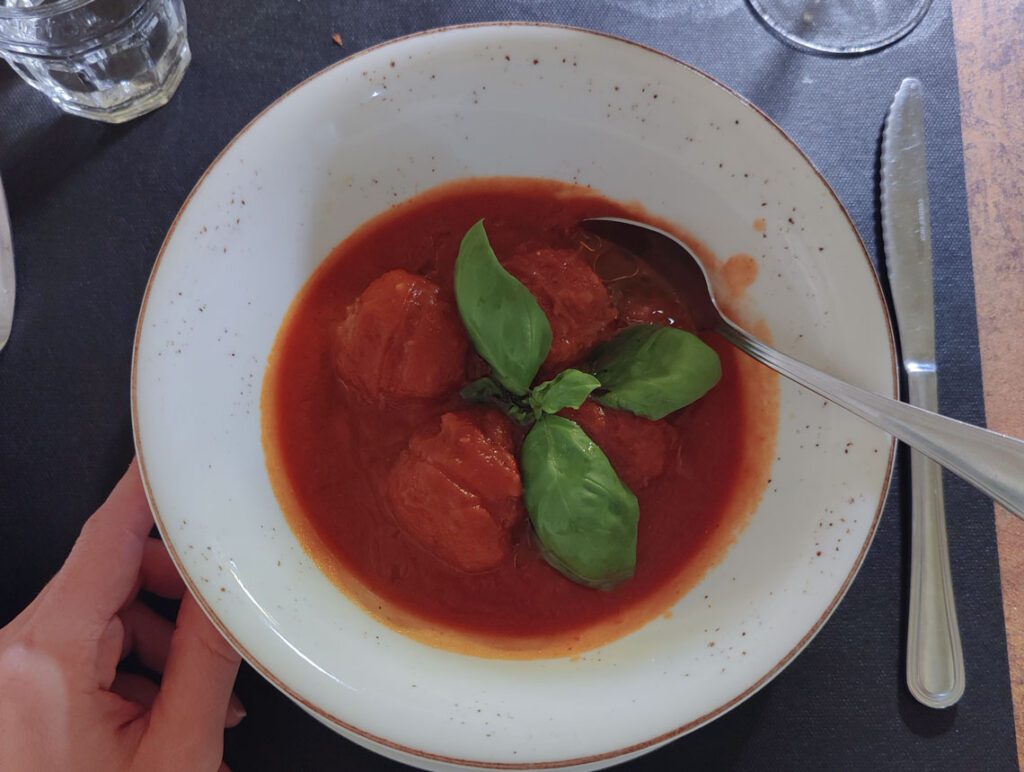
Excellent quality/ price ratio.
Address: Via Madonna delle Virtù 29, 75100, Matera Italy
Exquisite local kitchen in Osteria Materami
This tavern religiously follows the local tradition and its food is characterized by simple and genuine ingredients. The fresh fish comes directly from the Apulian coast and I fell in love with their fresh pasta served in the saucepan: a joy for the eyes and for the palate 😄
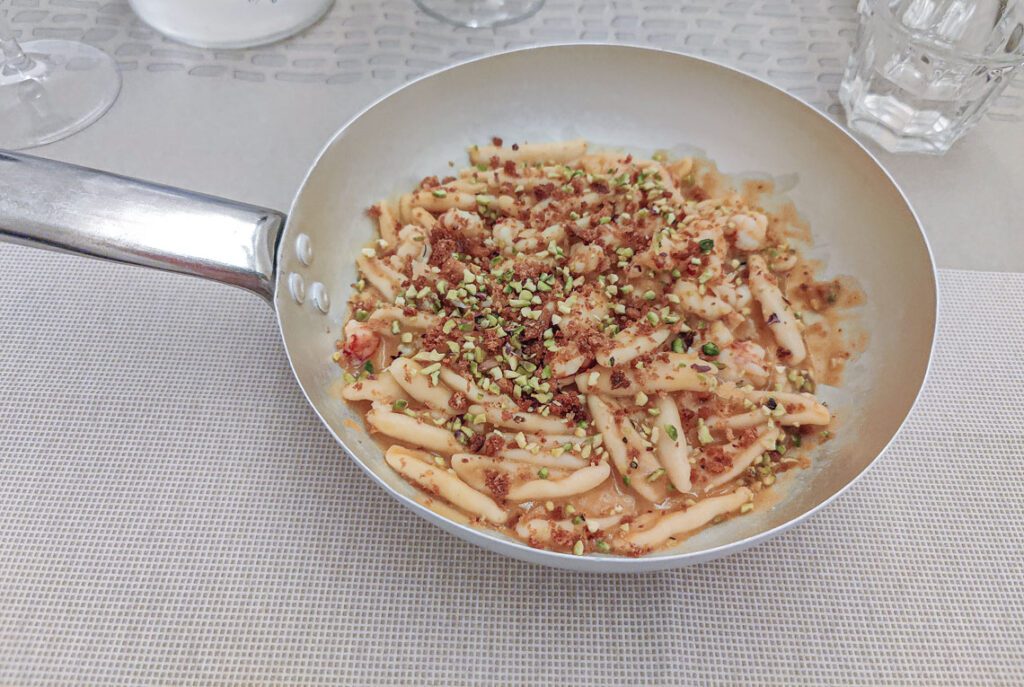
Here you can taste the typical sweet of Matera named Tetta del Monaco (the tit of the monk): a very light sponge cake stuffed with a soft cream that looks like…
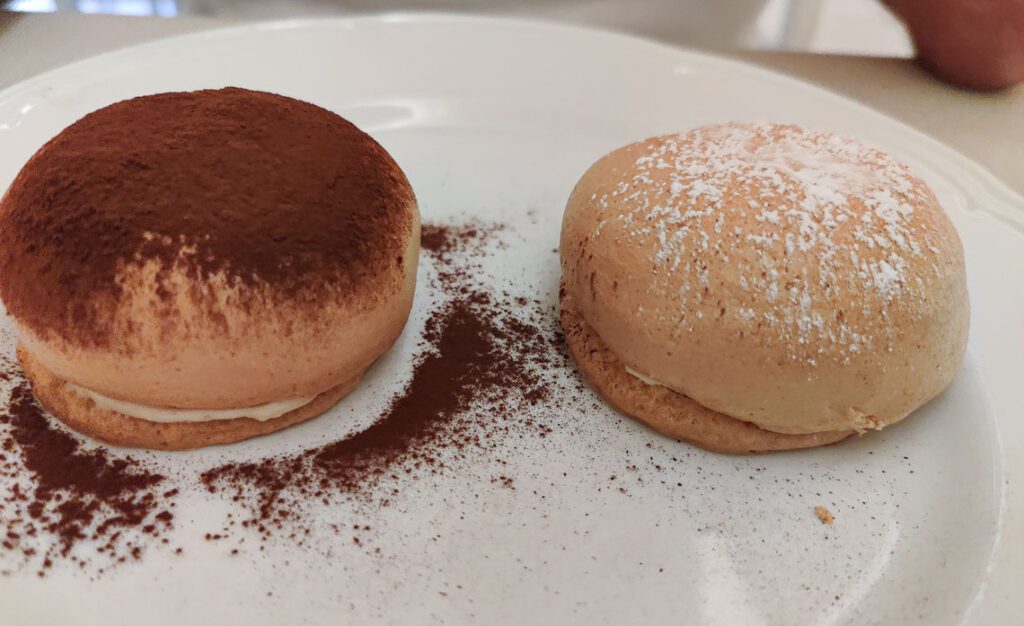
Good value for money and very friendly staff.
Address: Via d’Addozio 4, 75100, Matera Italy
How many days to visit Matera
A day will allow you just to have a glance on this fascinating city, not enough to appreciate all the wonders it hides. Matera deserves more, absolutely no rush and time for every corner. I advice to plan at least 2 full days to visit the main tourist attractions and join 1 or 2 guided tours.
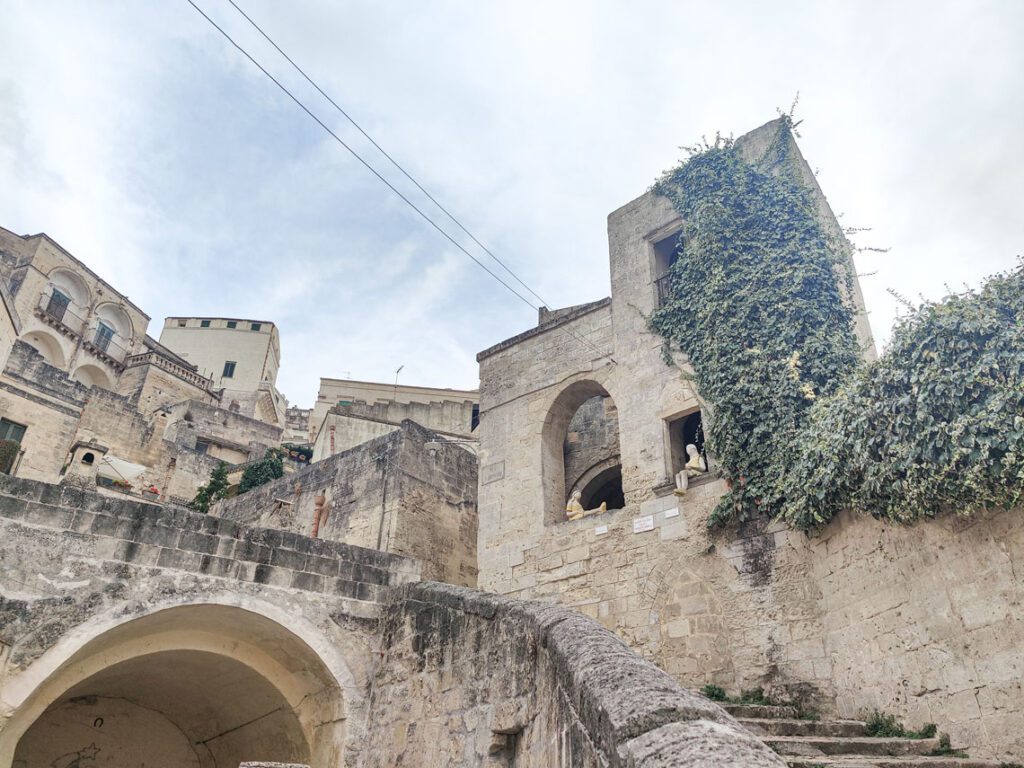
Note:
A special thanks to Giuseppe of Materaviglia, who introduced me to this beauty and gave me all the tools to understand what Matera represents for the history and the humanity.
When to visit the Sassi of Matera
It is possible to live Matera all year round but the best time is definitely in spring, between April and June, or as second option, in autumn between September and October, when temperatures are milder and there is less influx of tourists. In summer the heat can be very suffocating, while in winter the temperatures drop and the rains become intense. I was there in late September and the temperature was perfect for getting around the city all day.
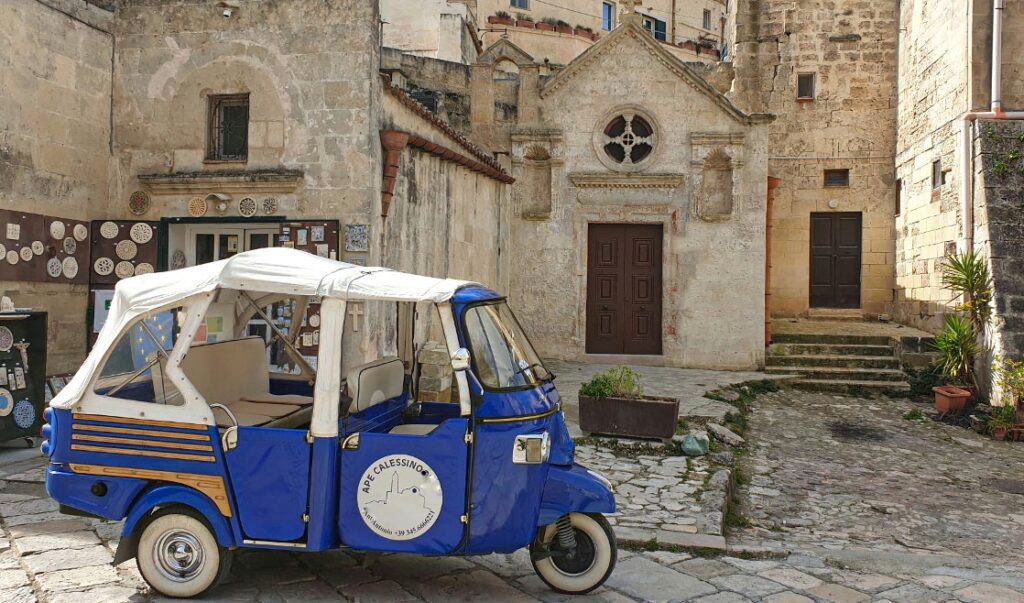
How to get to Matera
Definitely by car, once in place you can move freely to visit all the spots in the surrounding area and discover Basilicata too, without be worried about bus and train schedules.
How to reach Matera by bus:
There are daily connections with other Italian cities and the most famous company is Flixbus.
As an alternative:
- The companies Marozzi and Liscio which connect Matera to Rome, Florence, Pisa and Siena.
- Marino connects Matera to Milan, Ancona, Bologna, Naples.
- From Bologna, Modena, Parma, Chieti, Pescara and Rimini there is the Petruzzi bus line.
- Lecce, Brindisi, Taranto, Matera, Potenza, Salerno and Naples are connected by the Miccolis bus line.
How to get to Matera by plane:
The nearest airport is Bari Palese which is about 50km away. Once you’re off the plane, you can rent a car or use the Pugliairbus shuttle service to reach Matera. Alternatively, the Miccolis bus line also makes the same route.
Matera by train:
From Bari with the Appulo Lucane Railways you can reach Matera Central Station (inaugurated in 2019) in about 80 minutes. Be aware that during some weekends the service is replaced with a bus.
If you have read to the end, you will certainly be ready to make the most of your next adventure in Matera 😉









